Expedition to China 2006
All travel reports are translated electronically although minor improvements are sometimes made.
Expedition to China 2006
Traveling route: Qingdao-Beijing-Erljan / Erenhot-Beijing-Great Wall from Jinshanling to Simatai and Badaling-Xi’an-Army Terracotta-Luoyang-Shaolin-Shanghai-Hangzhou-Xiamen-Guilin-Longsheng-Yangshou-Moon-cruise by the river Li-chengdu (pandan conservation reserve) -Leshan.
Hong Kong, Macao and Tibet, although they are in the People’s Republic of China, I have described as separate countries.
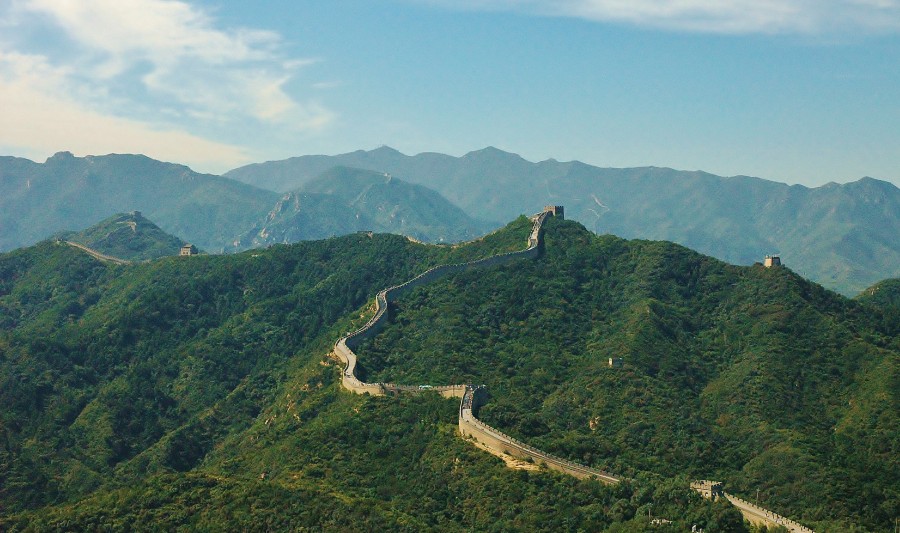
The Great Wall of China.
On the way to Mongolia.
In this chapter I describe my trip through the Yellow Sea from Incheon in South Korea to Qingdao in Shandong province in China, followed by my first impressions and adventures from Beijing, from where I got to Ulan Bataar in Mongolia.
Shandong Province
Qingdao
Getting to Mongolia can be very time consuming and abounding in adventures and many funny situations. Surely the trip to such a distant place is for everyone else and my adventure started in Incheon in South Korea. As I wrote earlier, I boarded a passenger ship in Incheon, who was about to take me to Qingdao in China. The ship was not luxurious, though the cruise was nice. I slept on a bunk bed with the Chinese around me and in the meantime took a bath in the big tub. After 17 hours of night cruise on the Yellow Sea, I arrived in Qingdao, Shandong province. After leaving China I went through an immigration position and was treated very gently, contrary to what I had heard from other travelers. I was greeted by policemen in traditional, airy caps. Then, with a taxi, I drove to the city center to get a ticket to Beijing. My first impression of China was: a lot of people and most of them collected very loud saliva from the throat to spit it out. It’s here, though, as I read the government’s already doing something about it because of the spread of tuberculosis. They go everywhere, even while eating and on the boat to the floor.
When I reached the train station, of course they all spoke only in Chinese. However, there are often students at the stations who come to help foreigners to practice English. To deal with them is very difficult and often they do not understand. Many times I had to repeat and speak slow, which makes it very tiring and causes headaches. I did not spend the day at the hostel. I just left my luggage in the vault and went to look around. Qingdao is even a nice seaside town. People bathed, many strolled, some even wanted to take a picture with me. See, I was more exotic for them than they were for me. Everyone was very nice to me but despite sincere willingness little help. In Qingdao in 2008 will be held sailing part of the Olympic Games. There are a few things to see here, but for me the most interesting was the town itself and the coast where the bazaar was. I saw there, among other things, creels made of cow horns, necklaces and shell figurines, and various types of fish biscuits.
Before leaving I ate a whole plate of octopus with bamboo sharply, came on the coast and watched people, or rather they were me. I noticed that there was even more choice of seafood here than in Korea, especially those on a stick. It is unbelievable that the Chinese stick everything that can be nabbed. Dried shrimp, octopus and even seahorses can be eaten like potato crisps from a bag.

With Chinese people interested in a white traveller.
Beijing – the first experience
In the evening I bought a ticket to Beijing for only 13 pounds (China is cheap) to after 9.5 hours and traveled 890km to reach the place. I settled in a car full of Chinese people and the next morning I was in Beijing, the capital of the People’s Republic of China. The first thing I saw was a big crowd. People were growing up from the ground, getting out of the station just took me a long time. I have never seen so many people at once. The second thing that kept me in memory was not difficult to notice the masses of spit. From there I took the metro to the hostel, but it turned out that there were no beds so I just left my luggage and did what I have always done. I secretly took a shower, smacked and refreshed and then went out for nothing. I came out with a big smile and said I would come back for luggage afterwards. I have to admit that I’m extremely cheeky, but that’s because I have to get some help.
Then I wanted to get a ticket to Ulan Bator, but it turned out that the next direct train would be in a week or one train in 3 days, but only to the border with Mongolia. As far as the border was concerned, no one knew anymore. I would like to say that the trip from Beijing to Ulan Bator would last 30 hours. Fortunately, she helped me in translating one very nice Chinese, small and not pretty, but she spoke a little English and she was very, very nice. I bought her ice cream. Another Chinese woman also helped me and even gave me a phone number to call if I had any trouble. Really, what a courtesy!
Buying a ticket in China is a real experience. In China train stations are always filled to the brim and people are not standing in line only push to the window and do the fuss. I had to find out what to do with my train, but of course I did not have one, because on one hand pushed me a horde of angry Chinese and on the other I would not get along. So I put up my Chinka to find out (she also tried to push in advance) and after a while it turned out that the train is gone. It cost me a lot of health. Remember that there are over a billion people here and everyone wants to go somewhere. There are tickets but 5 minutes may not be available for another 3 days. I know my story sounds ridiculous but to me it just meant a big headache. China is a huge country and although the distance on the map seems small, the actual 10 hours trip is a great fortune. I had a lot of trouble waiting for a week, which I certainly could not do, whether to spend 173 pounds and fly tomorrow, but only one way. An old Christian saying that faith in money works miracles is true, and whoever believes in it, may even fly to Mongolia – and tomorrow morning! So I bought a ticket, and I was planning to return back to Trans-Channel. On the same day I went to Tiananmen Square, but what happened to me happened then to Tiananmen Square. This will be a long story.
The next day I got up at 5am and drove to the airport. Unfortunately this time the flight was delayed by 10 hours. The guides warned that there may be delays due to weather. We were taken to a 4 star hotel where I could sleep and eat at the expense of Chinese airlines. In the meantime, I met some interesting people with whom I could talk about many interesting places in the world and have a taste of Chinese cuisine. It seemed that nothing bad could happen that day, yet. After arriving at the airport, it turned out that the immigration officer had snatched me an unwanted ticket while checking the document and left the proof of payment alone which was not enough to fly. I only had one hour to go and I had to do something.Nobody could help me and no one wanted to solve my problem. I felt bad and I was very pissed. Instead of nice, helpful chickens, this time there were only Chinese soldiers in caps like aircraft carriers. The only advice for my problem was to buy a new ticket for the same amount. So I ran into the office, I pushed through the nervous Chinese, (because each of them also had a problem) and bought a ticket, which was very time consuming and stressful. Of course I could not get along and the help was very slow and forced.The money for the old ticket will be given to me, but I do not know when. Apparently for a year. Fate wanted me to succeed again. Tired, nervous and having enough, I got into an airplane flying to Mongolia.The food on board was nasty.
All I have said so far about China was a collection of experiences of two days and I did it to show my first impression of China and how difficult it was to get to Mongolia because of my great bad luck. A more detailed description of China will take place when I begin to travel through this country.
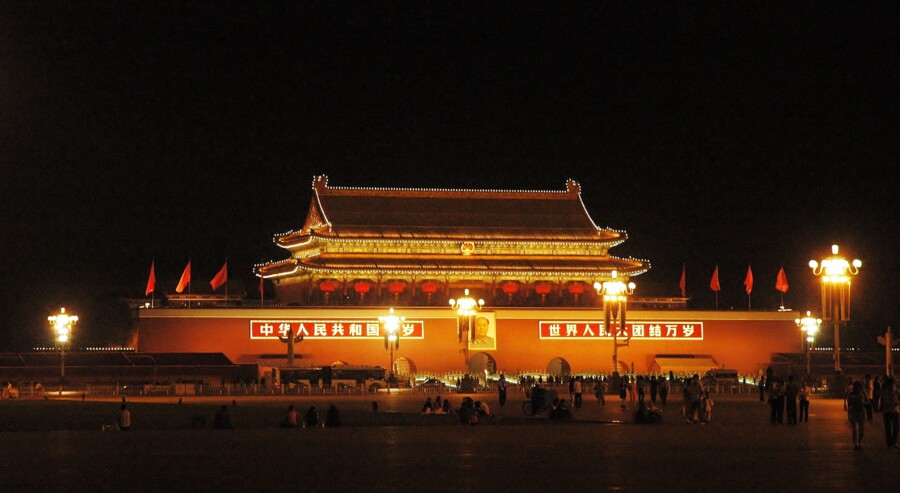
The Forbidden City by night. Beijing, China.
Mao Zedong
In this chapter I describe my impressions of a very special meeting for me.
One evening while I was in Beijing I went for a walk to Tiananmen Square. It is the largest square in the world, also famous for the slaughter of students by the Communist Party of China. At that time the student group was the only democratic force that could threaten the Communist Party. About 2000-2500 people died. (I will address this later)
I would like to tell you what happened that evening. Now, walking along this big square with Mao’s big portrait, two Chinese, brother and sister came up to me. It was two educated people who spoke fluent in two languages and studied journalism. I asked them why Mao Zedong is so popular and adored. His posters and photographs, books and watches with his likeness are sold everywhere. He said that Mao was a great thinker and father of a nation that created great, powerful China. I do not know if I was so stupid or so brave to say it to the Chinese at Tiananmen Square, but I was frank.
I said that Mao Zedong was neither a great thinker nor a father of the nation. Mao killed 60 million Chinese.It caused people to die of hunger and pregnant women told them to jump on their belly so they could have no more children. According to Mao, the force of the nation was his number, so all contraception was forbidden. Poverty and disease have developed, and China is still today. The Chinese made the reds angry.They said, “Well, everyone can make a mistake.” I said that 60 million murdered people are a good mistake.I said that Mao killed more people than Stalin and Hitler, because they killed fewer people than their beloved leader. The conversation was about to begin. I am reminded that I was in the heart of Beijing where it is better not to talk about certain topics.

In front of the gate to the Forbidden City, by the Chinese lion statue. In the background Mao Zedong.
The Chinese seemed not only angry but also confused. They did not know how to behave. They said to Mao’s defense that despite making “mistakes” he only wanted peace. I said that their Mao attacked Tibet in 1951, where thousands of people were killed and that Tibet is now part of China. Also in 1959, when the Tibetans wanted to regain independence, thousands more were killed again. Then, at which point Mao wanted peace, maybe I missed something. The Chinese responded that Tibet had belonged to China before, and Mao only took what was his. That was their version, but it was not the end of the conversation. I felt at that moment that it might be better not to talk about history. I was then asked about my further travel plan. I mentioned that I want to visit, among other things, Taiwan and Mongolia. My Chinese responded that the Mongols should be glad that they are independent because Mongolia was also theirs (some are so far). Indeed, Mongolia was huge (north to Siberia), but Russia and China took a bit. As for Taiwan, they did not know what I mean. Taiwan for them is only their next province with capital in the “Chinese” Taipei. I would like to remind you that the Chinese rockets are being aimed at Taiwan all the time and that they only need to be fired in case of greater manifestations of independence from China.
I said that I hoped that Poland, England and the whole of Europe would not be the next provinces of China. They just laughed and said they did not, because it was too far. I laughed too, because what else could I do. I told him that he was from a country where he was lying, where poverty and where there is no freedom of speech. They responded that their thinking idea is the best and that of course freedom of speech is the only difference, that in China people think more and less talk about their own choice. As for poverty, he said that the east coast is rich. I said that part of it is, but only thanks to British colonialism and Mao has never done anything good here. I’m surprised (I said) that he forgot how recently everyone had to walk in uniforms like Mao. (Returning to freedom of speech, I personally think that, although in England there is “democracy,” and so there is no freedom of speech.) Only the political system has a different name and greater freedom is that you can leave England when you want.
My last question to the Chinese was what they thought of North Korea. They said that the People’s Democratic Republic of Korea (democratically only by name) has always been their greatest friend and ally.I told him that in North Korea people live like slaves, there are concentration camps even for children, there is hunger and long range rockets are produced against anyone who is not on their side. The rest of China is also a violation of human rights (as in the West) !!! They just didn’t know about it ……
After this conversation, they were really nice to me and we went to a traditional Chinese tea house where we drank traditional Chinese tea, which was also very informative. But, apart from brewing tea, what is the morality of this whole conversation, even if young, well-educated people are avoiding the truth? Is China’s communist party plan to create an army of men with “cleansed minds” or simply mass lies forever? I think they can not threaten us now, because they depend on trade with the West and America is still a greater military power. It is sad, however, that this is the case here, even in the belief of young, educated people.
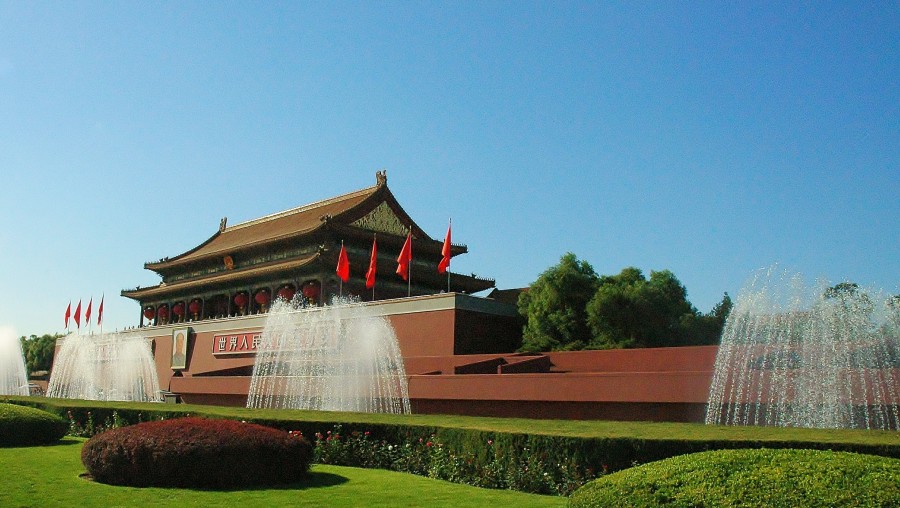
Main gate of the Forbidden City. Beiing, China.
Returning to the hostel alone I saw a Chinese married couple about the age of 75 doing a photo shoot with Mao’s portrait. It was obvious that it meant something to them. It was a great experience for them, even after more than 30 years after the death of their beloved tyrant. To this day, there is a long queue for the mausoleum where you can see Mao’s corpse, preserved in a chamber without air. In Tiananmen Square, you can not go quietly to someone who does not want to sell souvenirs after him.
I think there are still many generations of educated Chinese, who are best educated in the west so that thinking can change. The current population of China is 1.3 billion which is why it takes a lot of work and time.
The above described events are a collection of my experiences from one meeting, which is so much in my memory. I am sure that I will have much more to say about this great, contradictory country in itself.
Inner Mongolia province
Erljan / Erenhot
This is where my trip to China really began, and this time I was going to stay here long enough to get to know this country. Previously I was in China only passage on the way from South Korea. to Mongolia.
Erljan is the only border crossing point with Mongolia. When I entered here I immediately noticed the difference between the two countries. Erljan was much bigger, full of banks and luxury hotels. As before, in China, people were spitting on the ground and the streets were decorated with red lanterns. Being here I ate the best and cheapest meal during my trip. I did not stay here long, because I immediately bought a ticket to Beijing. The only thing that was heavy in Erljan was the ticket seller, who was the most depressing I have ever had. They got me a headache but then they seemed rather ridiculous. For them, it was a struggle for survival, and it seemed to me that earning a few yuan was a struggle for them. My colleague from Australia was always there, so it was better.
Road to Beijing
In China, travel conditions have been much better than in Mongolia. I drove a sleeping bus, so the beds were stacked on top of each other. Unfortunately they were very narrow and not always a good way to make me feel like I was going bobsleigh on uneven ice. On the way we also stopped for meals which was another good experience. In China we speak only in Chinese, so to avoid making a mistake I went into the kitchen and pointed my finger at what I wanted and then wrote on the card how much I should pay. When eating, most of them cried loudly and spat on the floor, which at the very beginning told me a lot about the culture of the citizens of this country. An amazing experience for me was the toilet. It looked like a group of Chinese people sneaked around to one trough and then the Chinese flushed the entire cargo with a bucket of water.
Despite these experiences, the thirteen-hour road to Beijing was very nice and painless.
Beijing – first impressions
In this chapter I will describe my continuation of the experience of Beijing. Having been here before I have described my first impressions and adventures but it was only a small introduction to this huge city and the rest of the country.
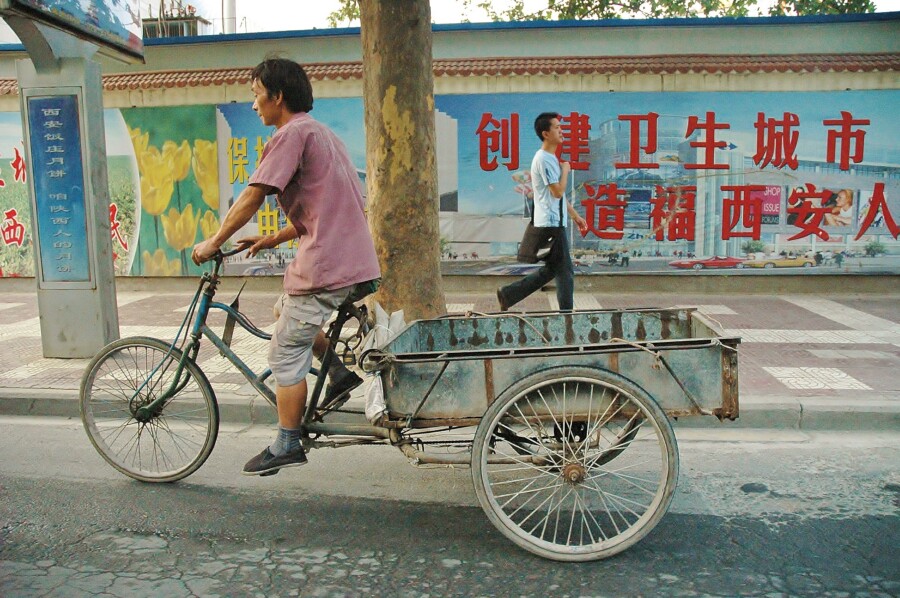
Cycling is still very popular in China, and not for pleasure, as in Europe, but mainly at work.
At last I reached the capital of the People’s Republic of China. This time it will be a long stay in this country and not a stop on the way to Mongolia. I am going to see here not only the biggest monuments but also to travel to other provinces in different parts of the country. I will go to small and large cities to try to understand the Chinese people and their culture and customs. This time I will have my faithful pet, Monica.
Beijing is a huge 12 million city, full of skyscrapers, gardens and temples dating back several centuries.Although the city does not look so huge it occupies an area almost equal to Belgium. This is usually the first stop for all travelers wishing to see the recently closed to foreigners, the Chinese capital. The Forbidden City, Tiananmen Square and the Temple of Heaven can be admired here, and Beijing is a great base for trips to the Great Wall of China. Beijing is also one of the most polluted cities in the world where in many places it is hard to breathe even though it is preparing for the Olympics the city looks rather clean and well maintained. It is very crowded and noisy, people are always in a hurry and there are plenty of shops and at night the biggest buildings and streets are nicely lit. This is my first impression of this great city, which certainly has a lot to offer. When I arrived, I first went to arrange the hostel but the entrance to the bus was marvelous because people were pushing into the dam. Three buses ran away until finally I managed to push on with my big suitcase. I was beginning to understand what it meant to be 1.3 billion people.
After a few stops I got to a cheap youth hostel located in a block of flats but the charge for a multi-room with a private bathroom outside was only 40 yuan, which is nothing much. This time, however, I paid 220 for a double room as I was expecting a guest. I did not visit the whole day just walking around town enjoying the new place. I was at a bazaar where I tried steamed buns with mysterious stuffing and watched elderly people play chess on the street. I also went to the lake where I bathed and then ate a plate of rice with roasted peanuts and bamboo. In the evening I also went to Tiananmen Square where everything was for sale (from dragon-shaped kites to Mao’s watch) and where I had a view of Forbidden City and Mao Zedong, the China’s beloved murderer. Late at night, I went to the airport where I took the journey taken Monica.I felt I would not be easy with her. I undertook to conduct a young white woman among others by China, Tibet, Nepal, India and Pakistan. I felt like I had a baby with me and I wanted to do it safely because stressless would not be possible. Next day we also walked around the city, tried Chinese delicacies and were happy to be here.
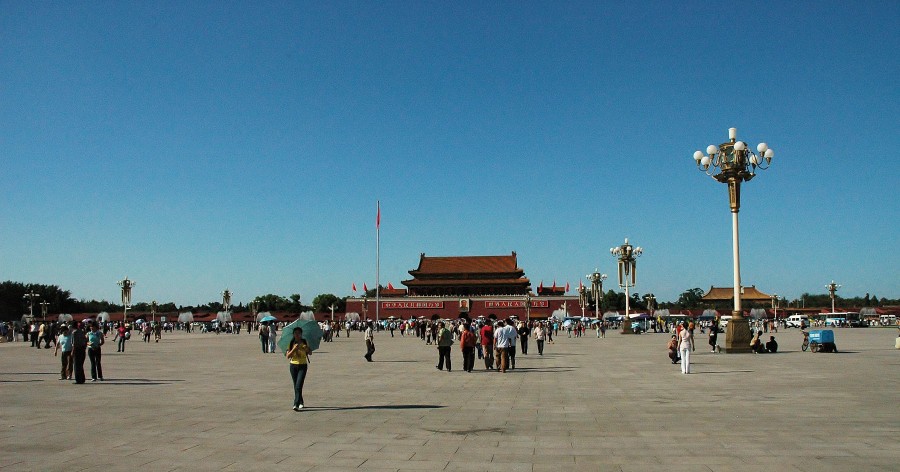
Tiananmen Square. Beijing, China.
Tiananmen Square
Beijing’s main attractions include Tiananmen Square. It is the largest square in the world, where Mao’s great portrait is clearly visible. Immediately behind Mao’s image is the entrance to the Forbidden City where there are a number of old temples. The name Tiananmen is the Gate of Heavenly Peace, which, from the point of view of history, is a complete denial of truth. Here Mao Zedong proclaimed the People’s Republic of China in 1949 and here in 1989 a massacre of 2,500 students demanded political reform. At that time, students were the only democratic force in Communist China, which the authorities could not afford.At that time, the army ridden the tanks and opened fire from machine guns to manifest, defenseless people and many were sentenced to death. I gave a brief history of this particular place, which is seen to be nothing to “heavenly peace.” I must admit that this square is impressive because it is really huge and there are objects worth visiting. It is an area of 800m at 300m where there is a memorial to the Heroes of the People and the mausoleum of Mao Zedong. Being here was a good experience, but the Tiananmen Square would not be the same without the people here. In the evening there are many desperate sellers who try to push souvenirs for very poor pennies. They sell postcards, kites, toys and much more, although the most popular are watches with Mao’s hand-hour clock and a small red book by Mao, in which he criticizes capitalism. Sellers rush to the customer, praise and lower to 90% of the initial price. Especially at the sight of the white man “from the broken west” have a wide smile. I advise you to spend more time here because the people you meet can provide many adventures. (One of them was described in the chapter titled “Mao Zedong”).
Night market
About a kilometer from Tiananmen Square was a night bazaar, which was another attraction of the evening.It was a street of jewelery stores, Buddha statues, tea rooms, restaurants and cheap cafes and many colorful neon signs. Monika most struck the difference of architecture and food, but above all the huge bazaars kneading under the pomp of goods for a few yuan-even more so that the price fell often by up to 90%. I think we have to stop shopping because we can not carry our goods and even cheaper India. T-shirts and red-stared hats are still popular today. You can buy all uniforms with a bonnet and an asterisk, exactly like the whole Chinese nation about 20 years ago. Today it is treated by many as a joke, which enjoys huge demand. I saw many tourists wearing Mao shirts and wearing cap hats. It does not matter that after pulling for one thread everything could go away. Everything was so cheap that we bought a few pieces. For a moment we also went to the tea room where we sat at a table made of one piece of wood and carved Buddha statue. This street also gave us the opportunity to get acquainted with Chinese art. Usually these were paintings where the landscape of Chinese villages, bamboos, pandas and the Great Chinese Wall were depicted. We also walked into a dirty and very cheap pub in the dark of the street where there was an unbelievable syph but the food was excellent. We were told pasta with peanuts and chicken and a sauce I never tried. At the exit, we even tempted the steamed buns, which are very popular here. At the end we took a bicycle rickshaw and so returned to the Gate of Heavenly Peace. We missed a few vendors and got on the subway.
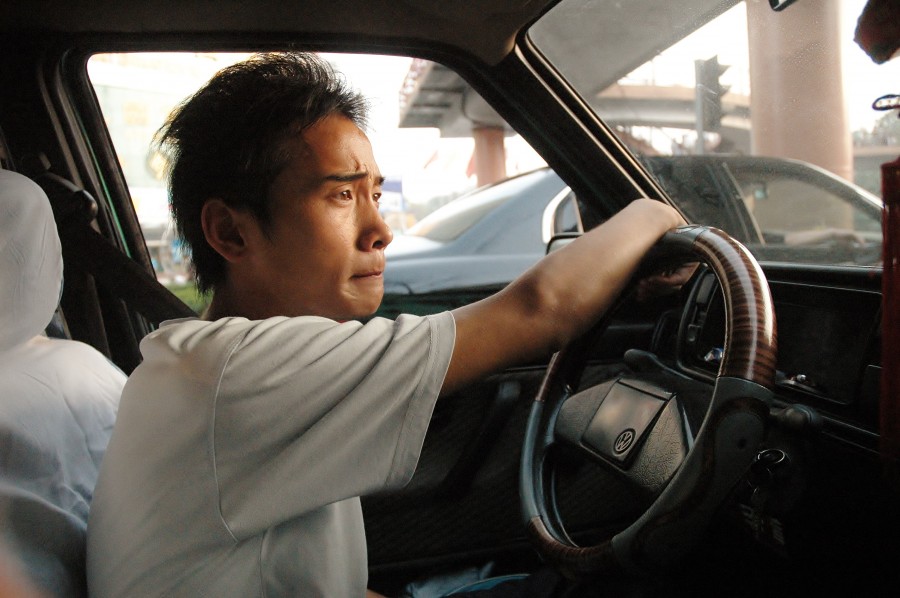
Chinese taxi driver in Beijing.
Chinese People’s Education
After a few days in Beijing I noticed something that is seemingly ridiculous but after thinking about it I think it is tragic. All Chinese people behave like an army and in all state professions people are trained and dressed like the army. For example, the metro service is compulsory in uniforms and red ties and round caps as in the police. In the metro are men who march on the platform to indicate the direction of the train, then salute and turn back. Even ladies who sell tickets have their pony on their shoulders. For example, hotel and restaurant personages stand out in the same spot where the manager checks their preparation for work. There are many examples. Until “beats communism here”. The good news is that the Chinese are not aware of the harm they have done to their beloved Mao and the communist party in power. This behavior is normal for them as well as notorious spit.
National Museum
This museum is divided into a museum of Chinese history and a museum of Chinese revolution. In this first there are rare collections of several dynasties that consist of sculptures, valuables and much more. The most impressive in my memory was the display of wax figures. There was, of course, Mao, but there was also Deng Xiaoping (the one who gave the green light to shooting students at the Tiananmen Square in 1989), Zhou Enlai (Communist Party Prime Minister under Mao), Confucius, Lenin, Einstein, Jackie Chan and Yao Ming (famous Chinese basketball player). Especially this exhibition was very interesting.
The second museum shows the history of the Republic of China until the founding of the People’s Republic of China. Next to the premises is the Great Chamber of People.
The chairman Mao masoleum
Mao Zedong has had a profound effect on China and many still show a deep respect for the leader, the nation’s father, although official figures say he was right in 70% and 30% was wrong. Apparently 80 million dead, sick, hunger, domestic conflicts, the hermetic shutdown of the country, the killing of the Chinese bourgeoisie, the scale of birth over force, etc., fall within these 30%. Besides it was wonderful. Anyway, after the death of a great leader, he could not simply be buried. All the more so because Vietnam has preserved the corpses of Ho Chi Minh and China can not be worse. The problem, however, is that the mausoleum is open only in limited hours and the queue is as long as from Poland to China. In the end I did not have the patience and gave up. From what I could find out from the Americans sharing the room with me, they said they were standing a few hours and then saw Mao’s corpse for a moment which was not in good shape. I only made a commemorative photo at the mausoleum, at the back with a monument to the leaders of the work.
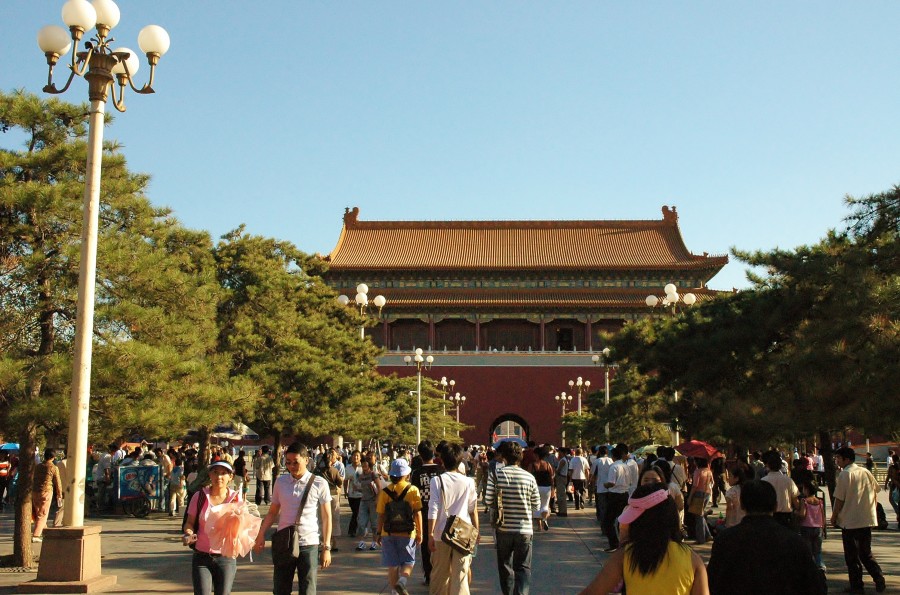
In the Forbidden City, Beijing, China.
The Forbidden City
The Forbidden City is the largest collection of palaces in the world and the next duty of every tourist. It was built between 1406 and 1420, that is, from the Ming Dynasty to the end of the Qing dynasty. For almost five centuries a beautiful city inside Beijing served as the emperor’s home and the ceremonial and political center of the Chinese government. The city consists of 980 buildings and is located in an area of 720 thousand square meters and was built in the traditional Chinese way. Forbidden City was a great inspiration for architecture in East Asia and in other parts of the continent and today it is a part of the world’s cultural heritage. There are many interesting buildings, sculptures and other art, remaining after the aforementioned dynasties. This extraordinary architectural phenomenon is surrounded by a thick wall and moat. The walls are decorated with towers covered with multi-storey roofs covered with yellow tiles. To the forbidden city I walked straight from the famous square through the Gate of Heavenly Peace (Tiananmen) to one of the five marble bridges. Opposite was the building of the Hall of Supreme Harmony (Taihotien) of 1627. Next was the pavilion of Chunghotien where the emperor was preparing for the ceremony and the Paohotien, or the auditorium. All three buildings are built on marble, decorated with elevation and high contrast is the difference of the white terrace from the red pillars supporting the roof.The most attractive looking building was the Taihotien, where coronations and celebrations took place on the occasion of the New Year and the birth of the emperor.
Behind this part of the palace, the Kienkingmen Wall is a complex of other buildings: the Kienkinggong Palace, the Kunninggong Palace and the Kiaotaitien Pavilion (Hall of Unity, which connects the imperial couple). The layout of these buildings was to reflect the philosophy in which the male and female elements connect. The Forbidden City is not just buildings and squares. Me and Monika spent many hours walking and watching the surroundings, the silence of the gardens and the artificial ponds. In addition there is a small souvenir bazaar and a military parade which every march and turn has mastered to perfection.
I think the Forbidden City is one of those places where you can go back often and not be bored. I also advise to visit with terrain map and not with headphones that are more misleading than explain.
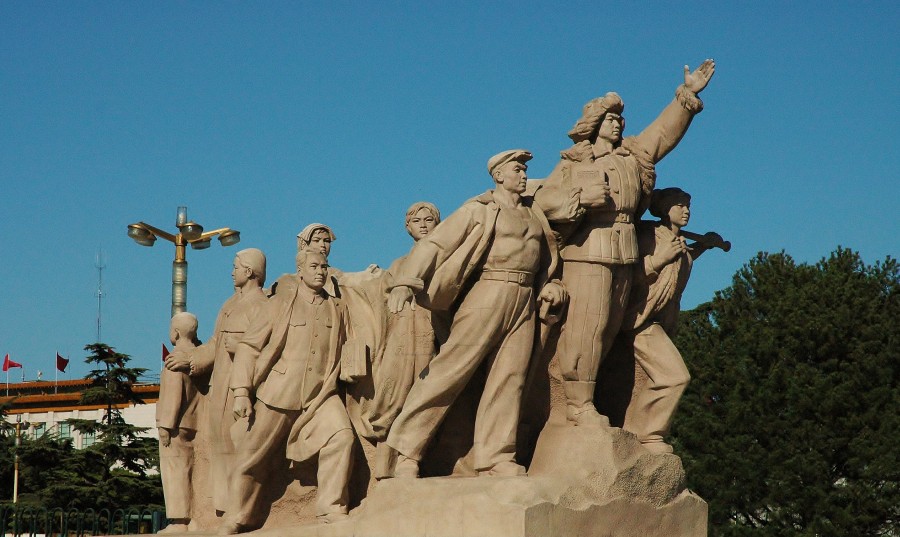
A communist monument in Beijing. People’s Republic of China.
Chinese fraud
This chapter I would like to devote to the ways in which the Chinese are trying to attract tourists to steal their money. The first thing is selling and I would divide them into intrusive and sophisticated, which works on the buyer’s feelings. Here it turns out how strong we are and whether we can say no. Wherever I went, they all wanted to sell me regardless of whether I wanted it or not and whether I ignored the seller. This is the pressure of the commodity where the price drops even by 90%. The way to find out is a character game that looks like this: When I was with Monica in one of the main squares two Chinese women approached us and started talking to us. They did not want to sell, we just talked about China and then proposed that they would take us to the national museum for what we agreed. When they arrived, they said they had their own gallery of pictures and would like us to see it. They walked us through the gallery, they were very nice and they gave us tea. Then they said they were all for sale but did not mention that for a very high price.When we did not want to buy anything they said it was a pleasure to let them know and they would give us a gift. On the rice paper they wrote in Chinese for me and for Monica. They gave us that as a gift, and added that this kind of picture looks good in old chinese frames, which we can buy for only 20usd. They looked into our eyes for a few seconds, and I said no, politely thanked, smiled and left. Here I have to decide whether or not to push myself. It was in their performance a show of great acting from the very beginning.It was based first on friendship and then on mercy.
The second way to make money is to take tea, and this is done in the following way. Chinese students get to know the tourists at Tiananmen Square and after a long talk they take them to a few glasses of traditional Chinese tea for special tea houses. Price for a few small tea cups is 100usd. I once went but after receiving the bill I kept the cold blood. I said I did not have a penny with me, so the poor Chinese students paid for it. But I asked for their phone numbers so I could give them money that never happened. I had a great time, especially since the victim became a predator and the view of the Chinese paying the card was the best. This is a very insidious, diplomatic game in which I have so far won because I have no qualms for those who want to cheat me.
I also noticed that the Chinese often want to deceive me on very minor things. I once had a quarrel with a rickshaw driver who agreed with me that he and Monica would take me to the designated place for a certain sum. He stopped 200m in front of the object and gave a sign to pay and went on to go himself. Of course I refused and the trainer for 10 minutes cursed in Chinese until he became red. Monika wanted to pay and leave but I played on time because the racer wanted us to get out. Finally he drove us where I wanted and I paid according to the contract.
Another example is my visit to a cheap, dirty pub where the poor meet. Of course, no one knew English, so I pointed my finger at them and they wrote the price. Sometimes I asked twice about the same and the price was changing. When I ordered it and it was chicken with rice in peanut sauce I could not believe what I saw. The portion of rice was large but on the second plate was a heap of peanuts in bamboo sauce and the chicken pieces were so small and rare that they simply hid behind the peanuts. After this meal I became ill.
I am sure that with the course of my journey I will come across more such things.
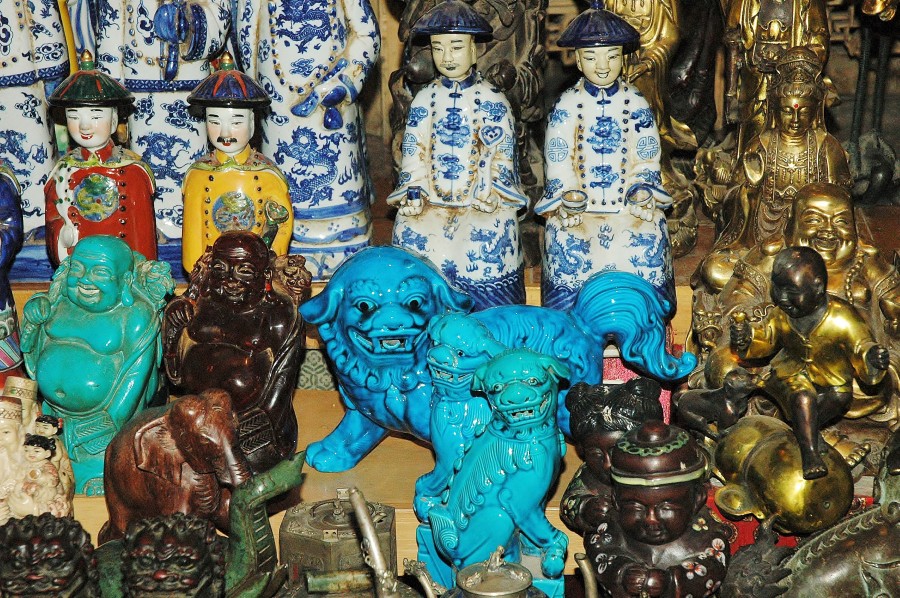
Chinese souvenirs in Beijing. China.
Tian Tan (Temple of Heaven)
Temple of Heaven is the most illustrious example of Ming Dynasty architecture. Temple of Heaven played a very important role because it was there that the emperor was paying homage to heaven to confirm his power. Today it is one of the most visited sites in Beijing, lies in a huge 267 acre park and is a popular meeting place. Even without going into the temple you can spend your time here. The gardens are very well maintained, it is clean, there is a small gallery of paintings and people play chess, cards and zink or a feather with feathers, which is copied to the partner. People here also play instruments and sing and in the distance above the wall you can see the Temple of Heaven. The symbolism of this place is important because the temples of the temple are round and square. This symbolizes the ancient Chinese belief that the sky is round and square.
The whole complex of buildings was built with strict philosophical rules. The names of the buildings include the Imperial Vault of Heaven and the Round Altar, but the central point is the most important of all, the Prayer Hall of Birth. It was built between 1406-1420 and rebuilt in 1740. It is made of white marble and consists of three storeys, each of which is completed with a roof characteristic of that period, covered with blue tiles (sky symbol). This temple is entirely built of wood and the roof is supported by 28 decorated columns, without the use of nails. 24 of them symbolize days and hours and the remaining 4 dragon pillars arranged in four different corners of the world symbolize the four seasons.Inside is a statue of a dragon representing the emperor of China. I am sure that the symbols are much more and each of the buildings has great significance and history but without being an art historian I am glad that I can explain so much. To me personally the entire temple complex was very interesting and worth a visit. This was another very Chinese experience and the park and surrounding exercise area is a nice addition.
The Summer Palace
In the suburbs of Beijing, there is the Summer Palace or the Yineyuan Harmony Nursing Garden. It was the emperor’s summer residence while he spent the winter in the Forbidden City. Out of all the objects I have seen, this one made a great impression on me, despite the fact that I have already been to many countries in Asia. The Summer Garden is the best example of combining the architecture of that period with parks and numerous gardens. It is situated on the Longevity Hill on Lake Kunming. The entire garden and park complex is spread over 290 hectares and has around 100 different buildings and temples. Over the centuries, this picturesque landscape was improved and enlarged, and more and more new buildings were added. The oldest of them comes from the 12th century, from the Jin dynasty. It took us all day to walk around the area, and we still didn’t see everything. Maybe because I pay a lot of attention to details. In the Summer Garden, many temples were built on a hill, some of which were difficult to get to.
As the level of sightseeing changed, you could admire the colossal temples and buildings stretching over many floors and shimmering with different colors, which look even more attractive against the backdrop of streams, dragon sculptures, large bonsai trees, carved bridges and many faces of the Buddha. I will also mention that the entire area and its temples were destroyed and restored. I mean, for example, the Second Opium War where many buildings were destroyed. Besides, Lake Kunming is not real. It was dug and Longevity Hill was made of what was dug from the bottom of the lake. In addition to beautiful views, architecture and a lake cruise, this garden is also a workplace for postcards, maps, watches, jewelry and much more. They pounced on me like wolves on a wounded animal and I had to be very rude to let them go. They followed us for about half an hour and did not respond to “no”.
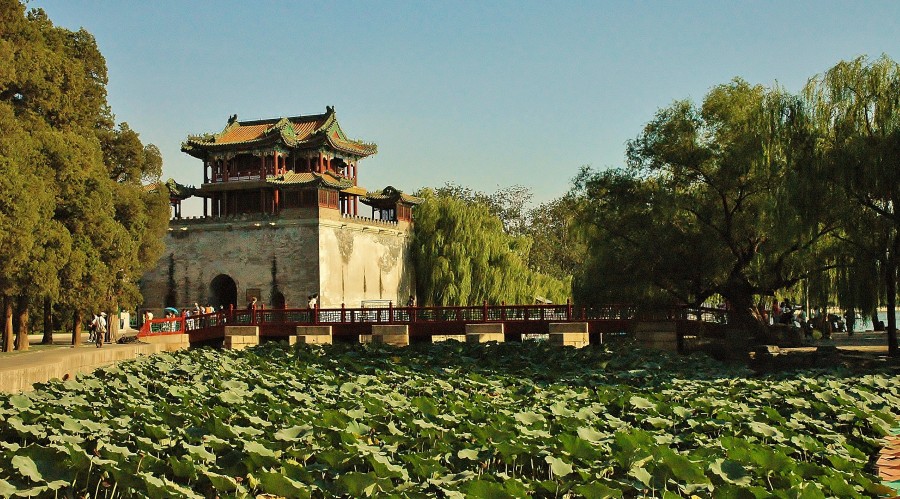
The Summer Palace, outside Beijing.
Also, the names of the buildings and gardens have poetic names such as the Garden of Virtue and Harmony, the Palace of Happiness and Longevity, the Palace of Scattering of the Cloud, the Temple of the Sea of Wisdom, the Gate of the Kingdom of Infinity and the Tower of the Virtue of the Buddha. From what I have seen so far, the culture and art of China from the ancestors is beautiful but it has nothing to do with the Chinese people of today. The Chinese spit where they fall and on every occasion they pee in their noses without shame and also wear white socks for black shine high. Going back to the Summer Garden, it was a beautiful experience and I would advise to spend here all day, not half as advised by the guide. Great architecture and sculptures on the background of the picturesque landscape make a great impression.Some of the buildings are in excellent condition and others are dying, but knowing the Chinese and their hard work for a few yuan, I think the Olympics will all shine. One other object that is very original against other objects is worth mentioning. It is a carved marble boat set on the edge of the lake, which unfortunately will not go anywhere.
The Great Wall of China
Approximately 60 to over 100 km from Beijing is the famous Great Wall. A building that you do not have to advertise and which attracts millions of tourists from all over the world (also from Poland). But before I go into the story of my personal contribution to “conquer the Great Wall,” I would like to recall the history of it and to say a few words about this extraordinary building which is one of the wonders of the world.
Construction of the wall began about 2000 years ago when China was united under the emperor Qin Shi Huang. The main goal of the wall was to defend against the hordes of the Mongols from the north. Several hundred thousand workers were needed for construction, many of them political prisoners, and the legend says that the builder material was not only earth and bricks, but also the remains of people working there.No matter how much construction and how many people died during the construction of the wall, it was a phenomenal undertaking. The Great Wall also served as a good transport line as people and goods were able to move quickly through this harsh, mountainous terrain. An important role was also played by towers from which fire was fired to warn the troops in other parts of the wall of attack on China. Mao Zedong said that whoever did not win the Great Wall is not a real man. Genghis Chan, on the other hand, says that the strength of the wall is not in the wall but in the courage of the people who defend it. As we know from the history of the Empire Mongolia conquered China and established its own dynasty on the throne in Beijing.
Today most of the wall is destroyed and only a small part is in good condition and only 1% is accessible to tourists. Most of this magnificent building lies in ruins or in the sand in the Gobi desert. (Full report on the Gobi Desert is in the description of my trip to Mongolia). Another important thing that is often misleading.The Great Wall is not seen from the moon. This is only the Chinese propaganda of the size of this country.How can one see the Chinese Wall when even individual continents are not from the cosmos to the end of recognizable.
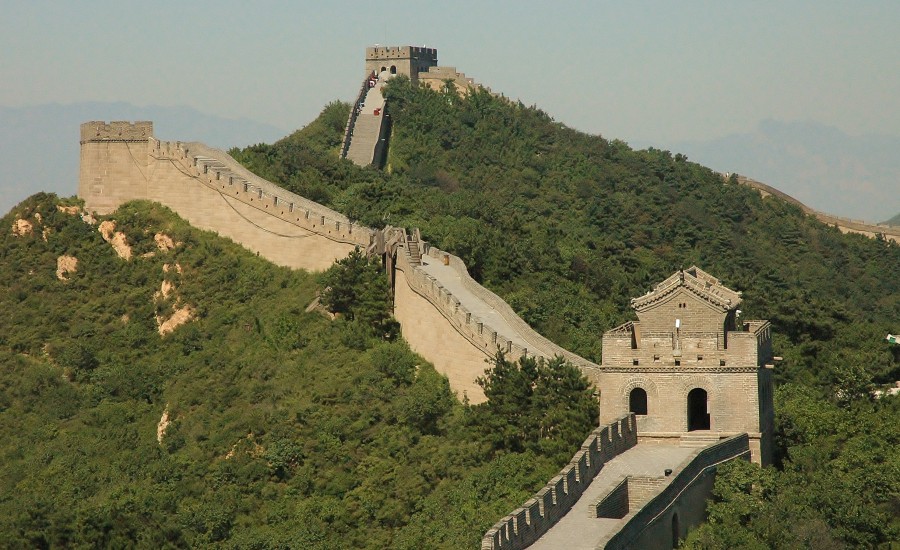
The Great Wall of China.
There are several wall sections available for tourists, in different distances from Beijing and with varying degrees of difficulty. The most popular tourist destination is in Badaling, although there are also Mutianyu, Juyongguan and Huanghua. Everyone is supposed to be a little different and everyone can enjoy a different panorama of the mountains, which differently presents depending on the season. The above parts of the Great Wall are easier, but I have chosen a difficult version of this particular place, and therefore decided to make an adventure on my own for the adventure to succeed. We took a non-urban bus to a town two hours away from Beijing, where we met two Swedes and from where together we arranged transportation to be cheaper. We went to Jinshanling (100km from Beijing) to get to Simatai, 10km away. We had to drive 32 defensive towers and had to get to Simatai before sunset in about 4 hours. We left the driver in Jinshanling and arranged an evening with him in Simatai. To be sure we will be waiting for him we have to pay him only in Beijing.
The episode I was going to go was not for ordinary tourists who just wanted to see the Great Wall. We had to climb mountains and ruined parts of the wall, because often large parts of it were destroyed and inaccessible due to numerous damage after many battles that took place here. In some of its parts the walls were thicker and in others I saw traces of the weapons used here. Whenever we climbed the steep walls, leaning on the exposed bricks, we covered the easy and difficult sections of the wall. Several times the wall was in such a terrible condition that we had to descend from the main wall and walk down the hill to climb up again. Personally, I felt great satisfaction and joy that I beat him just this way and not, for example, in nice and polite Badaling, good for retirees and pensioners. We also had to cross the bridge suspended on ropes that hung over the abyss. During my trip all the time we were accompanied by older Chinese, who for a few useless yuan wanted us to sell books about the Great Wall. They made it with such a facial expression as if their life depended on it. This was another tragic picture of Chinese misery, which the Chinese Communist government is trying to hide. In the meanwhile, passing other towers we had to buy tickets for the next part of the wall which was not so nice. We often filmed and filmed because each episode was different. We just happened on a beautiful sunset and we felt very, very tired. Passing 10 km on time in such conditions a little tired us. I am very happy that I did it just that way.
After all, we ate at an inexpensive pub and then returned to Beijing with the taxi driver we had arranged.
Another time we went to see this wonderful building in Badaling. It was just that part of the wall that was best kept and is most conveniently accessible to tourists. He was piston but it was beautiful. The wall itself and the views from it, book sellers and postcards, Chinese tourists and camel trainer were worth every moment here. It was easier on this episode than it had been described before, but it had to be over.
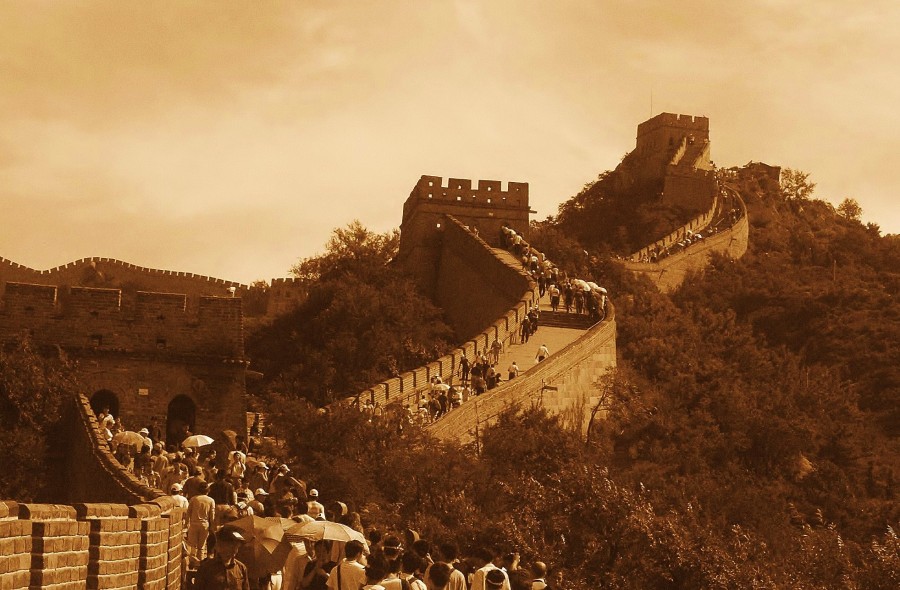
The Great Wall of China.
Hutong
Strolling around Beijing I used to walk on small and very narrow streets. They are often so narrow that they are best suited for cycling, do not look too attractive, often are not plastered and usually have one small courtyard and many close gates. This is quite different from the one I see in Beijing. I mean skyscrapers, skyscrapers and other such kind of attractive buildings for me. The above described hutongs are traditional, north-chinese buildings from the Yuan dynasty. Unfortunately, in terms of “development” and mania the size of hutongs are demolished in favor of modern buildings by what (in my opinion) the country loses on its tradition and history. Being in the vicinity of the Forbidden City, I advise to take a rickshaw and take a half hour hutong ride. There are many in this area.
Shaanxi Province
Xi’An
Departure from Beijing was almost as exciting as when we left Old Delhi (I recommend my reportage about India). At the last minute we jumped on the train but for the same ride was very nice because we were driving first class.
The next morning, after 14 hours we reached the capital of Shaanxi-Xi’An. I unfortunately felt terrible, I had 39 fever and all day and night I spent in bed sweating and swallowing powders. Fortunately, my lady was very good at me and the next morning I felt better. I think it hurt my chinese food, though on the other hand my chinese medicine was put on my feet.

With my travel companion in Xi’An, China.
Xi`An is a nice old town. Already before the Roman Empire, Shaanxi Province was the center of Chinese civilization and Xi’an was of a high standard. Today, however, it is primarily one of China’s major tourist attractions. It is also clean and less bustling than in Beijing, which was a nice refreshment after the capital of this great country.
Much of the local architecture looks new but is made up of old and traditional Chinese. Many roofs on residential buildings and on banks and offices are made like Buddhist temples which looks very attractive.
I think the biggest attraction of the city is the Ming Dynasty wall of 14 km long, 12 km high and 12 to 18 m wide. You can follow him or ride a bike, but unfortunately you can not go around Xi’An around because the larger parts of the wall are destroyed, although it is supposed to plan to connect all its parts. Like the Great Wall there are watch towers. For me it was a nice experience though without comparison compared to the original.
There are also some pretty Buddhist temples but those in Beijing or South Korea. The temples in Xi’An were no longer new to me. In any case, objects like the Little Goose Pagoda and the Big Goose Pagoda are still worth seeing. This is another beautiful temple, built in old style. It attracts with its splendid architecture, or elaborate roofs, pillars and sculptures, incorporated into an attractive garden. In addition to the Buddhist temples in Xi’An there is a large Muslim community which gives you the chance to visit the Islamic bazaar and see the Great Mosque though as for mosk it looks rather strange because it is built in Chinese style. In this area you can try muslim dishes and watch “bearded” at work. I also recommend the gardens around mosq.
I think there are two objects in the center of the city – the Drum Tower and the Bell Tower. With towers, they have nothing in common. These are high-set Buddhist objects from the 14th century, with characteristic Chinese roofs. Besides the beauty of this architecture, it is also a very good place to look at artists at work and listen to local music. I think the beauty of Xi’An is that almost all the monuments are very close together allowing you to explore the city in a short time.
I also went to the bazaar on Huajue Xiang and around the Temple of God City, which is also transformed into a bazaar. There were loads of merchandise, from traditional Chinese ornaments and memorabilia to canvas, silk, paintings, porcelain or traditional Chinese calligraphy. This place is especially interesting for someone who has just arrived in China because it is possible to do big shopping here. Unfortunately, pickpocketers are spoiling here who can steal without notice. I was fortunate to be cautious but met a few tourists who gave up robbing even twice in the same day.
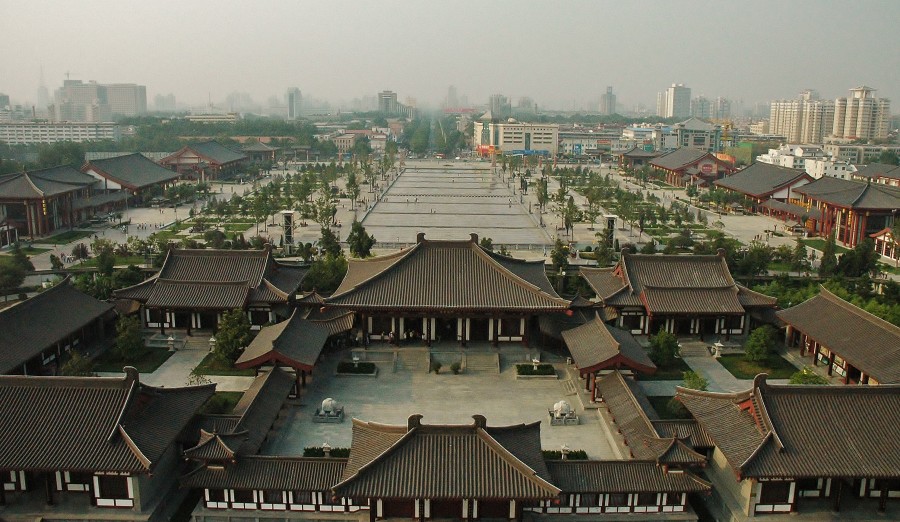
In the grounds of Giant Wild Goose Pagoda. Xi’An.
Besides, I was in the park where, for exercise on the grass, the janitor raised a scream on me. The police did not do anything but the Chinese were actively interfering, and one said in English that walking around the grass I kill nature. In China, unfortunately, the grass is only to look at it and the contact with nature in the larger city is being picked up. This is the first thing that I do not like in this country. In order to improve my mood, I invited Monica to the restaurant for the world-famous Peking Duck. Sexy Chinese women in red dress gave us sliced duck, to this boiled pot and heated pancakes with bamboo stems. It was delicious and the service was great, and then Monika was not in the mood.
I also remember that the ignorance of English among the Chinese came out for good. Throughout the day we rode the city buses for free. The Chinese did not know how to ask us for money and we do not speak Chinese either.
I think Xi’An should be on the list of anyone traveling in China, even those who have very limited time. As mentioned earlier, the night train from Beijing is only 14h. As for China it is no distance.
Terracotta Army
Xi`An also owes its fame to the fact that it is a base for the “terracotta army”. It is an army of soldiers and horses of natural size dating back to the first emperor of China Cheng (about 200 BC). This army is set up in a battle to the east and is most likely responsible for protecting the tomb of the emperor. Today, next to the Great Wall and the Forbidden City, it is one of China’s major tourist attractions. So far, about 8,000 figures have been discovered but it is estimated that there are many more to be discovered. This excavation was discovered by accident in 1974 when a farmer dug a well and came across a head of natural size.
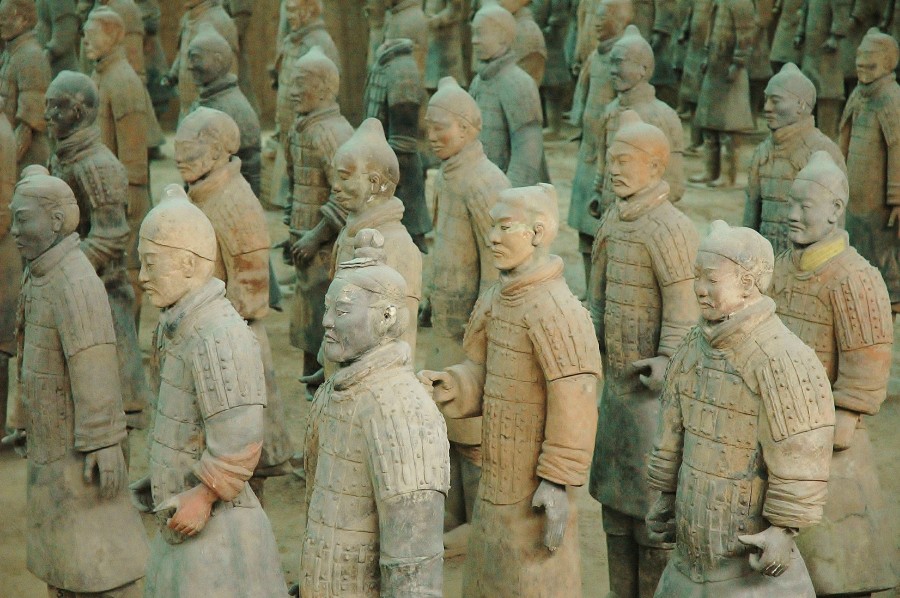
The Terracotta Army. China.
We made an all day excursion, as the property is about 2h away from Xi`An. The terracotta army is a great excavation under the great roof. Much of this has not yet been excavated due to the safety of the sculptures. It was evident that relatively large part was not complete because most of the figures were destroyed by the time and soldiers of that time. This work resembled long and arduous puzzles arranged from hundreds of matching elements. Sometimes the heads were missing the hands and parts of the corps. Also the weapon was not exposed because it was in another place. Seeing this monument was a colossal experience because the army of warriors of natural size and slightly reduced horses dating back more than 2000 years and located in the area of football field size can make an impression. Besides, not all the soldiers looked the same. There were infantry, horsemen, archers, junior and senior officers. They all had different outfits and took different positions depending on their destiny in battle. The soldiers also differed from each other with their hair, facial hair and facial expressions. I think that by creating a great terracotta army, the artists used soldiers as models, which certainly gave the whole better effect.
There was also the Qinyong Museum, where there were beautifully restored models of many different weapons.They were both generals and soldiers with a horse. As you might guess, these looked perfect but the real image of the excavation was at the bottom of the object, surrounded by earth. From what I heard, the farmer who discovered the terracotta army got a lifetime job in the facility, signs books for tourists and helped with digging. The whole was a fantastic experience and I would highly recommend it. (For those who do not go to China for some reason, I would like to remind you that some of the terracotta army figures are in the British Museum in London, though that will not be the same experience.)
It is funny that the surrounding towns have been transformed into factories producing copies of these monuments. The Chinese would sell everything, and they would soon be able to smell the business. There were shops where you could buy soldiers of all sizes, and at the entrance of the house the transported merchants pressed boxes of several clay figures for a wasteful pair of yuan. Within a few kilometers of the target, the great terracotta soldiers were set on the streets with prices hanging on their necks. If the figure was too large the shuttle was also not a problem.
On the way back I also visited a factory of Chinese furniture where I could see how beautiful they are decorated. There was also a Chinese art gallery where tiled kitchens were built with the motives of life in ancient China and mirrors and paintings, also in the same style. Although the terracotta soldiers were my main goal, the furniture factory was exceptionally beautiful. In the same place I saw also how the clay soldiers and terracotta horses were made for the needs of tourists. Right back to Xi’An we went to the jeweler and to the Chinese silk factory where I could try on their beautiful but expensive clothes. Exactly the same silk technology, although I have known this before in Turkey.
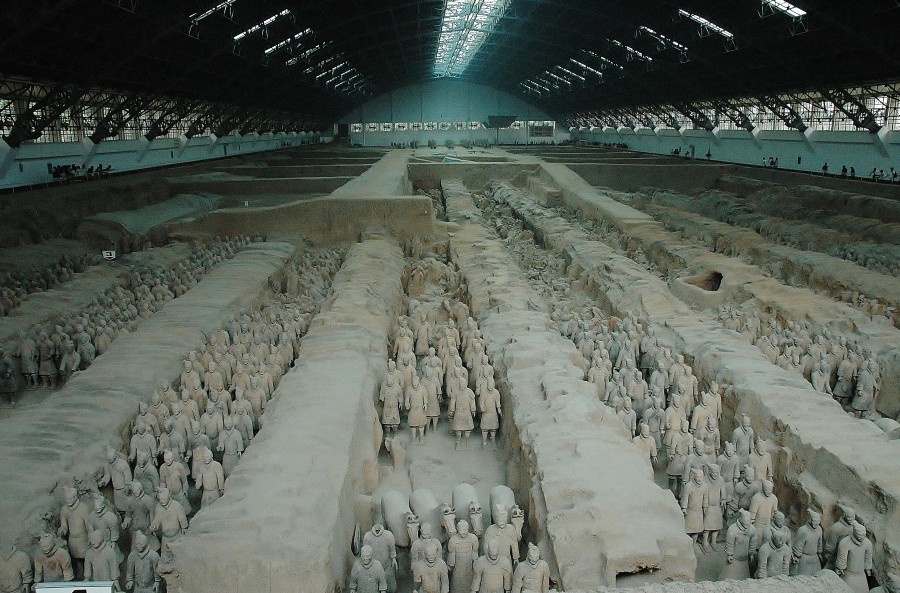
The Terracotta Army. China.
Xi’An-road to Luoyang and the “army of robots”
That evening we left Xi’An and went to Luoyang, a 6-hour train ride away. Unfortunately, the train was an hour late, but it was worth it. We saw how the chubby order kicked people out of the middle of the station because it was about to run an army and it lasted no longer than 2 minutes as people started to fly out of the seats. It was a unique spectacle: the army ran with equality up to 1mm spacing and they all sat down at the same time, looking just ahead. Designated also were the guards who stood guard for over an hour, again looking at only one point. I stood before one of them and tried to look him in the eyes but I did not succeed. It was too deep for me. At last the general came in hand with his hand in his pocket, completely relaxed, playing with the phone. After a moment when I began to doubt any sign of Chinese courtesy, there was something we could not believe. The same man who had just been thrown out of the station in the Gestapo was approached by us, then sat down with us and politely asked us to resettle because the army was about to come. When I agreed, he thanked and bowed. Then we watched a “robot army” for a while until the train arrived. This time, although we were riding in dingy conditions, was very cheerful with the filthy, spicy and smelly Chinese who came out all over the place. Me and Monika did the picture with “most beautiful faces” and then I even went to sleep. The conditions were not comfortable this time.
Henan Province
Luoyang
Luoyang was once the capital of 13 dynasties but today it does not resemble its old size. Walking through this city, I find it hard to believe that there was once a center of Chinese culture and about 1300 Buddhist temples. At the beginning of the twentieth century, Luoyang was home to some 20,000 people and today it is a six million population.
After 6 hours drive we reached Luoyang City. We got here at night but fortunately the train was waiting for us at the train station, which took us to the hostel. It was a poor room with bunk beds and a shared toilet where slept tourists from Europe and the States and who just as we were traveling on a low budget. We had a long conversation with them about China, the propaganda of this country and the praise of the communist government as a memory poem. One girl was an English teacher here and she said that the contract has been signed to make certain subjects not to move at all. For example, if the censorship is needed, the Chinese students replied that otherwise someone would harm their good and caring communist government. I have been trying to talk with the Chinese about Mao and the Communist Party for some time now, but I think these people are just afraid because they will not say anything bad about them. I said that, on the other hand, Chinese propaganda is not less than American or European. She’s just different. In China, care is taken for the size of the country, the immaculate Mao and the communist party, while in the western world it is mainly the overlapping of American-Jewish terrorism with the salvation of the world and stupid political correctness. At that moment the conversation was lost and we went to sleep.
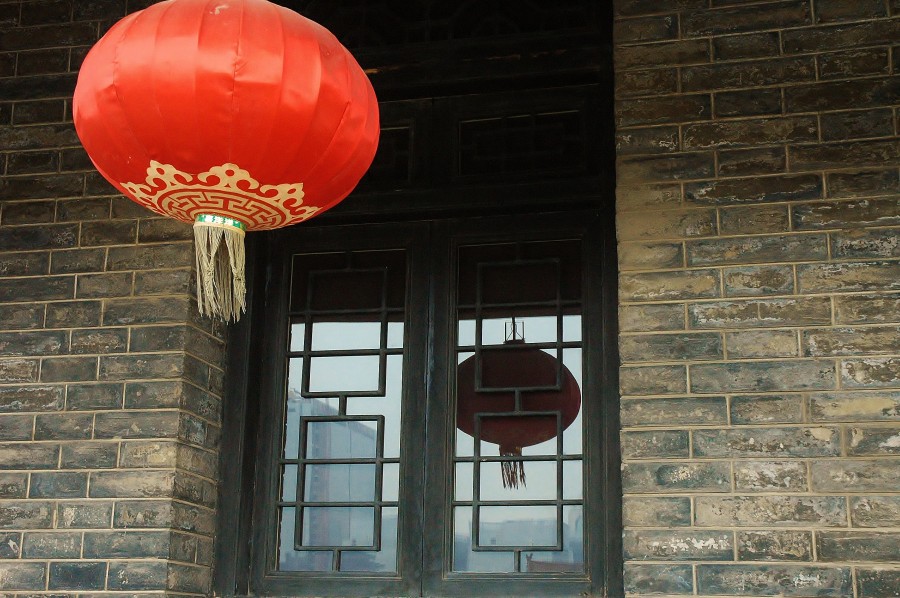
The Chinese red lantern is one of the symbols of Chinese culture.
Luoyang is a city where nothing special to watch was but just seemingly. As it turned out, even a small town in China is huge. I read somewhere that in a city there were only 50,000 people, and after a year it was already 10 million. This is what China is developing because even the smallest city is a city of several million. First, we went to a restaurant where no one understood us and where I had to choose “hit”, depending on which Chinese letters looked more inviting. Once I got up from the table and pointed the waitresses to what I wanted to eat because it was more reliable. As it is in China, people mumble and sometimes spit and the service was rude.
On a city bus by Luoyang, we stopped at the selected stops, then walked a bit and drove further. That evening we reached one of the many squares where people practiced and danced. Me and Monika also danced, classically in pairs as we always do. It turned out that the big square of people stood in a circle and started to applaud us. It was very pleasant. There was even the mayor of the city who officially greeted us in Luoyang and asked Monica to dance. The whole square of people watched us, clapped, people wanted to make contact. It was an experience we have not experienced in China yet. I would expect such behavior in South America but not here.
Then it was time for a snack, because to make my trip more flavorful we almost always try new things. This time they were very popular steamed buns steamed. These buns are medium sized rolls but here we also came across tiny dumplings of rice cakes and vegetables in the middle. They are always waiting for customers in bamboo, airy baskets. They also have delicious fruit stuffed on a stick, sprinkled with sesame and soaked in honey. I think these are the ones we could eat without restrictions.
Our stay in Luoyang was very enjoyable.
The Shaolin Temple
The next morning we drove to Luoyang, a famous Shaolin monastery 80 km away, where Buddhist monks practice and teach kung fu. This is a place that no one has to present and that was the inspiration for the legendary movies with Bruce Lee. Our driver drove us to all the surrounding temples in addition to Shaolin so I had to arrange the transportation myself to this place. The monastery itself occupies a large space with Buddhist temples with monks living there, kung fu schools, cheap pubs and accommodation. In this area you can also take a few hikes in the mountains where one trail is 15km.
First we saw some temples and meditating monks there, we walked on the mountainous terrain and we were where young kung fu trainers were. We also saw some sculptures of fighting monks and then went to a show of martial arts. The show was admirable, especially as the best ones performed here. Monks were doing incredible things and it was more exciting because we watched it live. For someone who has no connection to martial arts, it can be a great experience. I have to say though that the Chinese kug-fu, though beautiful, is different from the styles that I deal with. Kung fu, especially in monks’ editions, is a martial art that is largely based on acrobatics and gymnastics, but also of course in strength. The monks were very strong, agile and resistant to pain. Anyone who comes here, I highly recommend.

A monk in the Shaolin Monastery. China.
As for my opinion of this place, I think Shao Lin is already a very commercial place where there are so many tourists. Everything is beautiful and very well taken care of. At times it seemed to me that for such an old place it was too much. There are many temples in the middle of this great building, but after seeing all the previous ones, they have not impressed me so much. This is because some of them have been refurbished, which is part of their authenticity. There are not only many practicing monks, but also the thick ones who spend their lives praying. You can also meet many young Europeans who are struggling to shed extra pounds by fighting and running up the hill. This place has a special atmosphere and is definitely worth seeing.
Outside the Shaolin Temple stood a statue of a meditating monk and around a bazaar. We bought souvenir t-shirts and figurines of fighting monks and tried to return to Luoyang. In the meantime, the Chinese tourists were very curious with me and Monika so we posed for photos every now and then. We thought there might be trouble in the evening but once we left the road, two buses stopped near us with a squeal of tires and the drivers jumped and even threw us on their busses. I have never had to deal with such a big fight for the customer !!!
It was time for us to go to Luoyang, because the same evening we had to make a 15-hour train ride to the largest metropolis of China, to Shanghai.
Shanghai
Shanghai is called “Paris of the East” and is the largest port in Asia. Once upon a time, the British, the French and the Japanese had a tremendous impact on the construction and development of trade, which may explain why this giant is different from the rest of China. At first, it was a small town at the entrance of the Yangtze River, but after the first opium war began with western and Japanese investments, Shanghai became an autonomous region not governed by Chinese law. Very soon the city became the largest port of China and soon became the busiest in all of Asia. In other words, the wealth and prosperity of Shanghai comes from the opium, tea and silk trade, and the wealth and power of the city has attracted even more wealthy investors from the world.
Today, Shanghai is the fifth largest city in the world and the largest in China where about 40 million people live. It drives the Chinese economy and surpasses other Chinese agglomerations. I also think that from the point of view of the Chinese government it would be good if Shanghai and not Hong Kong was the first place in terms of economic power. The reason is simple. Shanghai has been “bred” on their own land and Hong Kong is a former colony.
We finally got to Shanghai. It was a long but pleasant ride. We stayed in a very nice, centrally located hostel with a pond in Puxi that is in the historic part of town. As soon as we entered, we saw a huge difference between Shanghai and Beijing, for example. Beijing, on the one hand, was full of beautiful sights and on the other hand beat the communists while Shanghai was more like a modern city of skyscrapers of glass and colorful neon lights. That evening we went for a walk and first went through Nanjing Donglu, which is the busiest shopping street in China. It is very bustling and colorful, also at night where it seems to be as bright as the day. The street was crowded and full of shops, commercials, lights and shows where a lot (like everywhere in China) was the street vendors who approached us trying to sell most watches though. In practice they had everything we wanted. At first it was pleasant but then only very tiring. We also reached Renmin Square where we saw the Shanghai Museum and the Grand Theater but did not go in because it was too late. All stopped by street vendors, they asked us names and origin to do business tired us so much that we had enough. As soon as we reached Shanghai, the coast, where social and commercial life flourished, and from where on the other side of the Huangpu River flourished and well-designed high-rise towers and towers. After an hour’s walk we finally reached the river where we saw the beautifully lit Shanghai skyline. I was on a big promenade where everything was for sale again. There were a lot of restaurants on both sides of the skyscraper with the most sophisticated shapes. Here you can see how much Asia can be dynamic and advanced. I think Europe is not as big a city as it is. The Shanghai coast is modeled on Hong Kong, but each one is very specific and therefore different from each other. Here we can see the great progress of China, which unfortunately I can not say about the poor people who pushed us postcards for a couple of yuan. It was late in the evening but the nightlife was very animated. It seemed that this city never went to sleep.
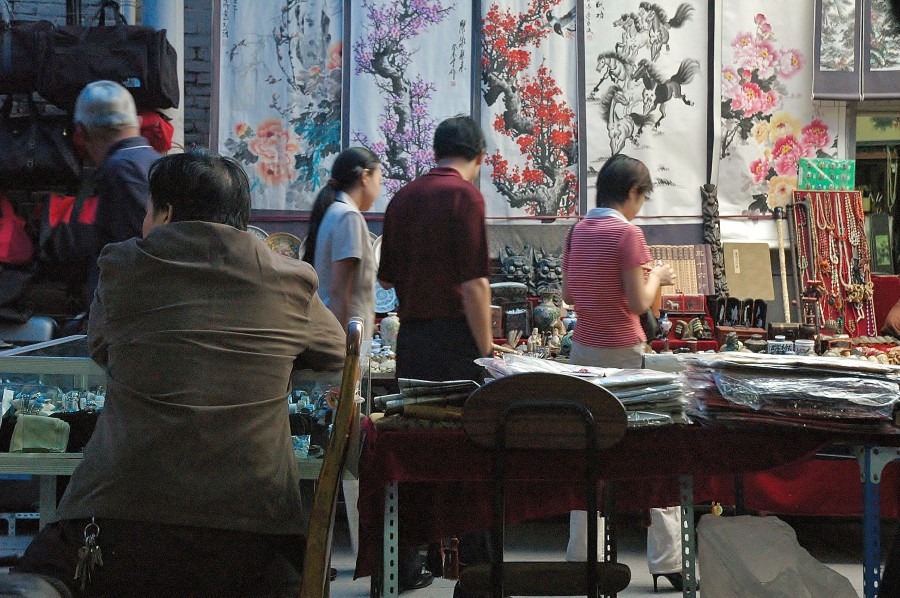
At the bazaar in Xi’An. Chinese art in the background.
The next day we went down the shopping street to get to the coast where it was as usual. At all times, many people were taking photos and trying to sell something. Most memorable in my memory remained the distinctive mark of this particular city, ie the Oriental Pearl Tower television. It is 468m high and is the highest in Asia and the third in the world. Thanks to it nearly 20ml of Shanghai watch TV. This is the district (Pudong) attracting the most tourists as here besides the pedestrian street on the Hangpu River with its famous skyscrapers buildings, there are also several colonial buildings such as the Peace Hotel and other skyscrapers of the Pudong district. One of them is the 88-story Jin Mao Building with the world’s tallest hotel, the Grand Hyatt. Everything around was great and quickly changed the colors of the lights. You could even feel the tones of money and gold pumped into this great entrance to great China.
On that day we also flew to the other side of the river, where it was clear that there were many skyscrapers in the state of construction and where the promenade on the river bank was alive again. We sat in a nice park at the Oriental Pearl Tower, bought ice cream and glasses for only 20 yuan and from there we looked at the Pudong district. On our return to the other side of the river, we went to the Huangpu Park first in the city with the famous People’s Monument and then returned to the hostel by Nanjing Donglu. This time our accommodation was especially attractive because in addition to the pond was an artificial brook where the fish and turtles red swimming. So sipping a jasmine tea and playing billiards we stuck a bit in this nice place.
The next day we went to an older district where several streets were transformed into a big bazaar in traditional old buildings, with roofs like Buddhist temples. It was a Yuyuan bazaar located in the old part of Shanghai. All the buildings were quite new but designed in old Chinese style. We arrived in the evening for what we did not have the best pictures but it was so beautiful. The roof edges were illuminated, as were large red lanterns. We walked the small streets, admiring architecture and sculpture and bargaining in numerous shops packed with goods. It was primarily Chinese art, or landscapes with tigers, bamboo or panda teddy bears. There were also traditional red ornaments, Buddha figures and lanterns. Yuyuan bazaar is also a good place to buy traditional clothes, fans and jewelry. I would share the diamonds here for a real fortune and not quite true for a few yuan. Anyway the atmosphere of this place was very nice. We drank tea in traditional Chinese tea rooms, ate steamed buns and went for a professional Chinese massage. I was already massaged in Thailand, but for Monika, who was famous for laziness, it was something wonderful. I bought some souvenirs and returned to the hostel. It is a pity that we missed the Yuyuan garden, which is a whole with a bazaar but unfortunately that day it was closed.
Upon returning to the hostel we were preparing for a further trip but left outside to a small park to practice.But we had to do it secretly in front of the guards and under the cover of the night because in China we can not walk on the grass.
I know we should stay in this great city a little longer, but the time has come for us, and after three days I left Shanghai. The city has so much more to offer but I felt a bit tired of the skyscrapers, street traffic, drivers pretending to not see pedestrians. Shanghai is a nice element of my trip, but it does not depend on it. This city will always be mentioned as a technical card of China for the next century.
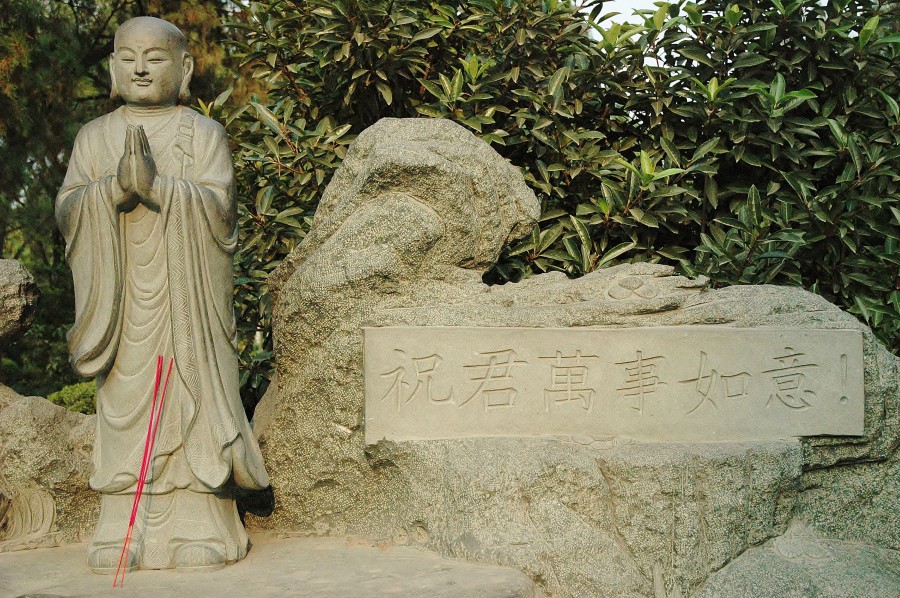
Although according to the communists ‘religion is the opium for the masses’, Buddha statues are often seen.
The ‘Glory’ of China
I have been traveling in the main part of China for several weeks, moving from city to city and from province to province. I think it’s time for me to say something about this country in general and about the Chinese themselves. Going through this huge country, I talk about the monuments and the cities that I had an opportunity to meet see. But I think my expedition is based more on true knowledge of the country and people where the truth comes out only when I travel on my own, just like me. In spite of the many wonderful things I’ve seen here, there are also many others that I do not like very much, and what makes for an impression that the imagery is often misleading. If I were to describe this country in one word I would say it is “huge”. Everything is big here; lots of people and big cities. Even if I’m leaving for Beijing or Shanghai for a potentially small city, it turns out to be a multi-million dollar city filled with skyscrapers and street traffic like in any European capital. Each city also has its own airport or even its own airline. Wherever I go, there are many telebimos, and social life flourishes in the streets. It seems that people live here well, although it is largely just such an impression. The east coast and tourist centers are good, but the western part is very poor. One Chinese in the hostel told me that the western part of China is so poor that there is nothing just and people are living in poverty, dying of illness and inadequate. But this time I’m not going. Even when I looked at the map of China, in its greater part (west) there are no roads, railroads, electricity and no infra-structure – unlike the east. I think all the old cities in this country are similarly delusional. Everything is big and there are lots of people and skyscrapers everywhere.
As for the Chinese themselves, of course they are nice and helpful. It happened that people helped me find an address or buy a ticket at the station, they escorted me where I wanted and sacrificed their precious time. They also try to speak English although they do not come out and English is very limited. However, I think that, given not individual individuals but the Chinese nation in general they are very simple and idiotic; poorly educated. I have already mentioned that they are very spit on the street and loudly gather saliva, whether they are in the park, in the bank, or on the train. They also munch and eat with open mouths. They often do not pay attention to what I say. Even if it is in their interest they listen only as much as they want and then behave as if I was not there. For example, the bank asks the same question twice, and when there is no answer, or even a sign that they are listening, I have to get out of the way to get my attention. I think it may come from an ignorance of English, but still it is a bit rude. It is strange that I have learned a few Chinese words here, but they do not speak English. Chinese people often complain about their rations and most unfortunately smoke cigarettes. They can not stand in line and point fingers. It is a nation that, despite its old culture, is also very vulnerable to propaganda or simply afraid of it. I stopped talking about Mao Zedong because in his eyes he was a great father of the nation and at the end of it.When I ask about Mao’s 60 million victims or hunger, etc., they say that Mao has made a few mistakes but will never say straight that he was a nasty tyrant. Also the Communist Party is very good for them, despite the massacre of students at Tiananmen Square. I also spoke with an English teacher from England who teaches in China. She said the contract says that certain topics with young people can not move because they will be released immediately. Here is one of the best examples: The English teacher asked a group of 16-year-old Chinese: “Do you think it’s good that the press in China is censored?” The answer was at least shocking: “Yes, we think the press needs to be censored. Otherwise, poor people could destroy or threaten our great communist government. “ After this, I understood that the conversation with the Chinese on certain topics is like fighting windmills, because they have brainwashed or are unable to accept the truth because they are afraid. For comparison in Myanmar where there is dictatorship (even children are slaves) and where I was almost 2 years ago, people very cautiously talked to me telling me the truth. (More in the Myanmar report). But in China, the whole nation is silent as if spellbound or do not want to understand what I’m saying.
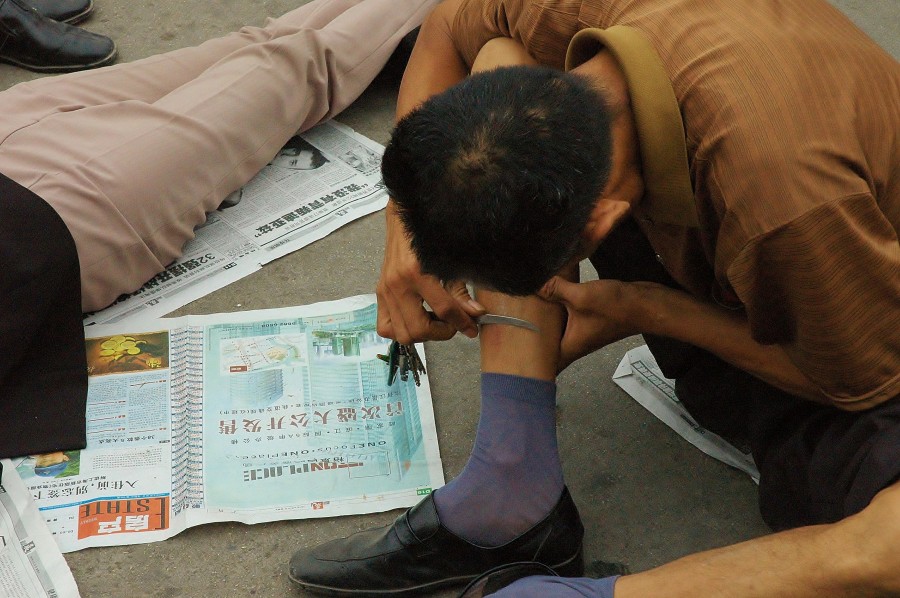
There are aspects of Chinese culture that China chooses not to advertise. Some of them are shaving and rude spitting in the streets, shops and offices. Fortunately, some of these things improve.
Chinese men are very “elegant”. They always wear trousers in the edge, to this shirt, they all wear black slippers and often white socks. They have overgrown fingernails, smoke cigarettes, and sometimes even jeans have the edge. Unfortunately, despite their elegant style, they rarely feel the perfume. Most often they are bad or just stink. I noticed that they also smelled of their lips and most of them spit. I also noticed that every time I remove the money, hundreds of pairs of eyes are automatically turned to my side. I would say that the Chinese as a nation are very thoughtless. It happens to me that if I order a tea I do not get sugar. If I get sugar because I ask for it I do not get teaspoons. If I order toast with jam I do not get a knife or napkin. I must always make sure that I speak out loudly and clearly all the things I need, which everywhere in Europe are normal. Often also do not give me money in stores just thrown in my direction.
I think that in order to travel to China on your own, you have to arm yourself with enormous patience and good humor, because despite the beauty of this country, many things are rife. I have been in almost all countries in this part of Asia and I have to say that things are better for example in neighboring Laos or Vietnam, which are also communist countries. In China at least nobody asks me to return to the hotel aiming at me with a rifle, as it was in Laos. Well, every country has its own bad and good side.
Another thing that I do not like in China is the huge bureaucracy. Every time I check in at a hotel, my passport and my visa are thoroughly scanned, even if it is the worst place. Travel checks can be made only in one bank and sometimes only one branch in the whole city. Each time you have to fill up piles of papers.Even if I want to use the internet in my city, my passport and my visa are scanned. When I asked why, they said that such a law is against foreigners and that it is for my protection. It seems to me that the government in every white man sees a spy.
The good thing here is that China is very open to educated Europeans. While still in Beijing, I had a job interview as an English teacher. I was checked by an Englishman who works there. They offered me a salary that was a little worse than in England but allowed me to live in China very comfortably. I would also have paid and paid a flat and a special kind of visa. I still have some time to think.
I think that the thing that wears hair on the head in China is the state of the local toilets and those with weak nerves should not read better. These are just holes in the floor and most often are in deplorable condition. But the train toilets are the worst. Very often the doors separating the cabins are broken, and then you can see a dozen of Chinese-trained people, one by one. It is also strange that from such a marketing situation nobody does anything because I did not feel that someone was ashamed. They just take off panties to relieve themselves. I used to open the cabin by mistake and saw one Chinese pretend I was not there and crouched when I looked at him. Women are the same. This is not what luxury toilets in South Korea, where you can let go of the fantasy with the stool.
The next thing is everyone knows the great Chinese cuisine but not as great as it seems to those who have never been here.
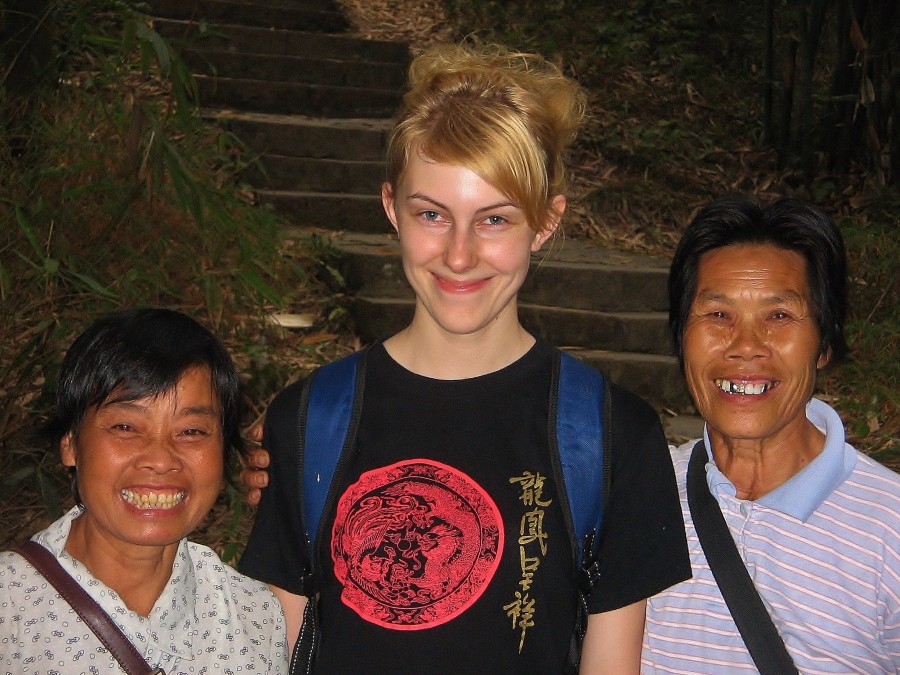
The Chinese are interested in white travellers. Sometimes we are their only source of information from the world, and our version is different from theirs. In this photo however, it was only about meeting an exotic tourist.
Chinese cuisine is first and foremost a great variety. Me and my Monika always order something else and then share it to try everything. This is a food that tastes great but unfortunately has a lot of bad sides. In China there is plenty of food, everything is here and nothing is wasted. It often takes time to track the trash.For example, a beautifully presented chicken can only be a skin with a minimum of meat, and under this there are usually wings and neck where the meat is almost nonexistent. There is always one dish on many plates, separate soup (sometimes tasteless), separately spices, salad and the rest. It looks like a great dish consisting of many entrees, but it turns out that there really is not anything to eat. Even if everything looks very good and you can see that it is a decent dish, the food is still risky. I was poisoned and got sick twice and Monika once. It seems to me that Chinese cuisine in Europe is purely comparable. In addition, the Chinese do not distinguish between breakfast, lunch and dinner. They fry their pork and spicy, greasy, spicy sauces at any time of the day or night. My delicate stomach can not stand it.
In addition to all the beautiful things that this huge country has to offer, it is also a great country of trash, falsity and shoddy. It is so with the shoes, which in a moment they are spreading out or from which the legs hurt, or with the shirts that are washed and strawberry yoghurt tasteless strawberries,
Very good trains and sleeping buses. You can make a very cheap and well traveled country. The bad thing about trains is that these “wonderful” toilets are closed at all stops (just like in Mongolia). If someone had a diarrhea on their food, they would have to wait for the train to move or just do the panties.
Despite many negative things in China, it is still a country worth seeing, where people are usually very nice in their own way. As I mentioned above, you need patience and understanding. This is not just about traveling to China but all developing countries or other cultures. You have to get used to the fact that things are not like home and that they often fail in action. Although people try, you can not expect too much from them (I mean, for example, changing habits or improving interpersonal communication). In summary, despite all the bad things, I am living here very well and I’m glad I’m here. My observations are still ongoing.
Zhejiang Province
Hangzhou
After leaving Shanghai we drove to Hangzhou only 2 hours away. Of course it was another big city like all here. With the difference that it was lying on a big lake, that was why it was possible to rest on it.
After leaving the station, local transporters offered to transport us to the hostel for a small fortune.Fortunately we were smart and took the bus and then a cheap city taxi. We arrived at a nice hostel on West Lake (Xi Hu). Unfortunately I ended up with cash and it was here that I learned that checks can only be made in one branch of a bank in a large city. Hangzhouspecialnie did not impress me because it was another big city but part of the lake was lovely. The whole area, in the eighteenth century was the property of one of the emperors and today attracts tourists with its charm and silence. Especially when traveling from Shanghai, Hangzhou is an oasis of tranquility and natural beauty; Of course, you do not have to go out and go to the bank smelly bureaucracy.
We spent the whole day walking around the lake. We crossed the embankment to the island, saw some temples and went to the botanical garden. There is also a koi koi swimming pool and small, secluded places that are very romantic in the moonlight. There are also many restaurants and architecture in the old Chinese style. Being in Hangzhou we did not go too far into monuments and museums. We only enjoyed the time we spent with the lake. It was a nice stop on the way to south China.
Fujian Province
Xiamen
After two days in Hangzhou we went further. This time we went to Xiamen, a 26-hour drive, in Fujian Province. It is a nice port city in the south-eastern part of the country, which is one of the largest ports in China. Xiamen is slightly different from the cities I have visited so far. There is a subtropical climate, palms are growing everywhere and there are banana plantations. In Xiamen you can also admire the colonial architecture as this place also has a rich history. It was a Portuguese, British, French and Dutch colony that made Xiamen one of the major ports in China. Each of the colonists built this town in their own way, which you can see walking along it. After a few years they took over the Japanese, and Xiamen continued to serve as an important port. Xiamen is also a city famous for its seafood. I have seen here even sharks and morayas and the most exotic species of mussels. Like everywhere in China, there are plenty of shops, bazaars and colorful lighted skyscrapers where people on the main streets trades and drowns in their own merchandise. It was a pleasant evening. I bought a new suitcase and sneakers for a couple of yuan, which as it turned out only lasted a few weeks. We saw a few colonial buildings, enjoyed the view of the Chinese bargaining and the taste of the local food. Unfortunately, we got sick and of course it was food poisoning which proves that in China we still have to watch out for food. Well, the hostel was nice and had a garden so this time it was not completely wasted. I planned to come to Xiamen from the beginning as it is the nearest base to Taiwan. I always wanted to go there, for the sake of the Chinese, whether it’s part of China or not (I do not think so, but about that later).
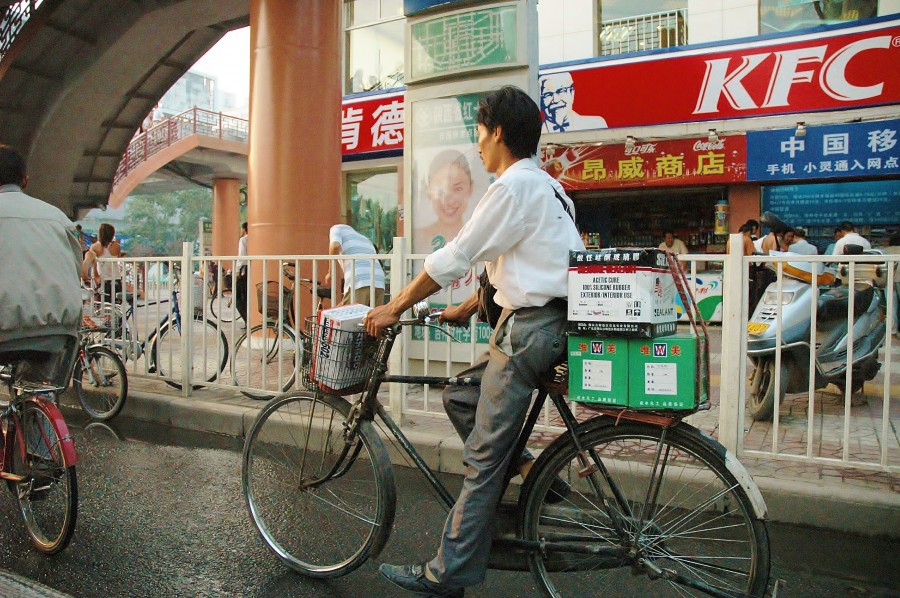
Until recently China was known as the country of bicycles, just as now Vietnam is ‘the country of mopeds’. After the Communist revolution, the Chinese paid for their bikes in installments. A car was an unattainable dream.
Once we roughly saw this busy and crowded city, we went to the main attraction of Xiamen or the island of Gulang Yu. Transport takes only five minutes and one way ticket is only two yuan. The island was beautiful, there were a lot of palm trees, boats and fishermen and the mountains were built of hotels and restaurants which was wonderfully integrated into one. Narrow streets rich in colonial architecture were rising higher and on both sides of the street were shops and restaurants with seafood. Gulang Yu Island is an old part of town where we spent the whole day. In a relatively small area, we could go from Portugal to the Netherlands. We could sit on the rocks on the shores and in the shade of the palm trees and then pick the fish that I had thrown at the frying pan on my wish. The whole island is famous for those restaurants where the fishing is displayed in the bowls outside. This is the wealth of all fish and crustaceans and can be ordered as desired although not too cheap. I bought myself dried fish and dried skewers from the squid though the selection is endless. We spent the whole day walking through the parks and “south European streets with Chinese character” and spent time at the seaside. Finally we sat in a nice restaurant, on the terrace overlooking the illuminated city at night. I chose mussels and then we just ate and I thought about how nice it was and whether we would be sick again the next day.
The next day we went by bus to Hong Kong, which I will visit for the second time.
At the end of this report I would like to explain why we did not go to the planned Taiwan, which is so close to Xiamen. Taiwan is a country not belonging to China, although China did not recognize its independence.Traveling to Taiwan is more complicated than it might seem. I planned to go there by ferry from Xiamen (in China), but ironically, it turned out that in Taiwan you can get from every part of the world except the main part of China, because the Chinese side has a bad relationship with this country, trying to take it and make it difficult traveling there. The only flights to Taiwan by China are from Hong Kong or Macau. But these flights are very expensive, because the Chinese side wants to make it the most difficult to get there by controlling ticket prices. If anyone wants to get there from Beijing, it must fly only through HK or Macao as a special administrative region of China. If the relations between China and Taiwan were normal, I could get a very cheap and fast ferry from Xiamen. So I thought that during my next big trip I would go to Taiwan by ferry from Japan, which would be much cheaper and as fast.
Road to Hong Kong
Here is the story of my trip: We took the bus from the previously described Xiamen. The bus was comfortable and the price of the ticket was included a dinner consisting of seafood. While driving I met a very interesting American who has lived in China for 11 years and even spoke Chinese. He told me many interesting things about this country, which enriched my knowledge (as to the description of China from the previous reportage). He said it was true that the Chinese were brainwashed because they were legally incapacitated by their government. Comparing your life with the age of 10, the average Chinese is happy, because he has jobs, he earns miserable pennies, which are enough for him to live a life of 50 to 150 USD, (although there are those who do not earn at all), has to eat and Where to sleep, although there is a rich elite. Therefore, in their opinion, the government is doing a wonderful job and what the government says must be true. No one is questioning this, and those who do so are in trouble. I am referring to human rights violations, torture, concentration camps, student slaughter in Tiananmen Square, etc. All is simply better not to think about it and not talk about certain topics. As a foreigner, my American friend could wear American cable TV, but he had to sign a police signature that would never give any Chinese a chance to watch it. If programs such as the BBC or CNN were available in China, I think there could even be a civil war here. The BBC and CNN websites do not work in China (I checked), but in Hong Kong there is no problem.In HK I even saw a poster with the head of the Chinese government and the victims of torture below and the great inscription “who is the murderer here?”. In South Korea there were many places of this type where you could see pictures of the victims of the Chinese concentration camp. My friend also said that if I wanted to come here and teach at one of the universities to find my way, I could write an invitation to give me a yearly business visa. He also said that if the Chinese wanted to leave the country, he would have to pay a huge deposit to the government (which he could not afford) as a guarantee of his return. The American also said that China from the tourist point of view is a beautiful country, worth seeing and understanding, but as long as we do not go into politics. The problem is that every traveler is interested in what destroys the beauty that surrounds us, even if it does not concern us. Without dipping into it, we might not even notice that something like this is happening and that it is a communist country because people laugh, eat in bars, be nice and kind. Besides, seldom anyone speaks English, and those who speak speak silence. I told him that from my experience, China is beautiful, worth learning about a country rich in culture and tradition, and only my knowledge of the Chinese government subtracts the beauty of this country.
Guangdong Province
On the way from Macao
In this report I describe my trip after leaving Hong Kong and Macau by the Guangdong province. I pass to him through the city of Guangzhou en route to Guilin in Guangxi province.
After entering China from Macao, I felt that at that moment my continuation of the great adventure of this great country began. I looked around and realized how big is the difference between HK and Macao and real China. The last two places were beautiful but China is the place where I can find the essence of my journey. As usual there was a buzz and there was a crowd, everyone was pushing and when I asked for directions they answered in Chinese. I thought this was exactly what I needed because recently I was probably informed too well .
I reached the station by bus and took the bus to Guangzhou, which is 3 hours away from Macao, but it was only my stop on the way to the new destination. The scenery in the south of China was tropical. Especially when I left Macao, the turquoise coast and palms stretched for a long time. After reaching the place again, I found a big city with skyscrapers and a crowd of people. They had a very good and new subway where a few people spoke English, everything was very well organized and the city was nice and clean. At closer inspection I also saw dirt and poverty but it is everywhere. I thought that China was a country of paradox because on the one hand there are big, rich buildings and streets and on the other hand poverty or even poverty. I think that the government is investing a lot of money here in developing the country so that it looks not only big but powerful as well but nothing or very little is invested in people. I liked it here but I’ve seen quite a lot of Chinese cities. My next destination was Guilin, a 10-hour bus ride north of Guangzhou and the nearby Yangshuo. Both these towns have always been described as quiet and surrounded by the specific mountains that cross the river Li. I wanted to go there because I knew I would have a chance to see the real Chinese village and the nature of this region.
Guangxi Province
Guilin
After a 10 hour bus ride but sleeping on the floor, we reached Guilin. We had a very nice, nice room (as always in China) where after a few hours sleep, taking a shower, doing laundry and eating something warm, finally slowly began to remind ourselves.
Guilin itself was beautifully situated, surrounded by mountains and full of small streets where locals were selling their own food. I felt that here – in Guangxi Province, I will see something new and good to be able to like this country even more. Gulin is very popular among foreigners and Chinese tourists because of the surrounding natural beauty city. It is one of the greenest parts of China, surrounded by mountains and near the Li River, which makes the locals become a bit greedy. As for the mountains, they are not as we imagine mountains in Europe. These mountains look like tall bodies with a relatively narrow base, so that the top and the base are sometimes the same width. When you see a small town on the background of so colossal rocks and a beautifully carved river crossing this city, and in the distance very high two Buddhist towers, this is a charming sight. There are many tourists here, but still it is quieter and quieter than in other cities.Souvenirs are sold, there are a lot of restaurants and an atmosphere that does not want to leave. Neighbors of this type are very lazy and make me not meet my travel plans according to the scheduled time although it is always enough. As usual we stayed in a cheap but nice and clean hostel in the city center. It was a convenient location to start walking. On our street was a large bazaar where you could buy vegetables with rice and learn about a trip in one of the offices. Unfortunately I quickly lost my humor and despite the natural beauty of Guilin, I knew I would not like it here.
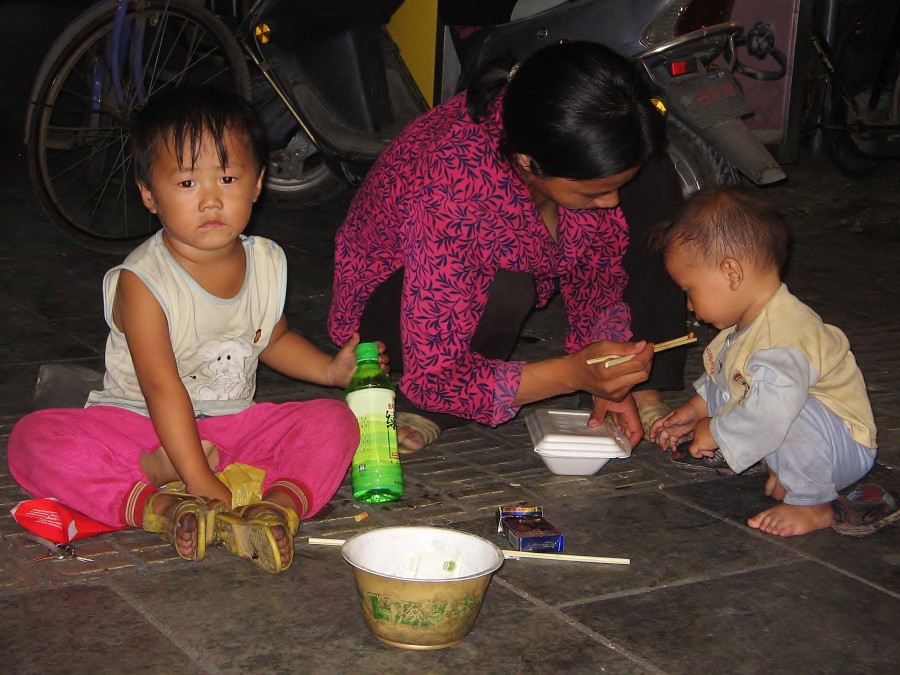
Poverty in China is noticed quite often, although it is certainly not as common or as dramatic as in India.
Very often I saw a menu of meat from a dog and a cat. But I was moved when I saw my beloved turtles and snakes closed in cages and waiting for death. Frogs are also commonly eaten. It was before every restaurant and I could not agree. Walking through the city many times I saw cages in front of restaurants, watered nets with reeds and reptiles and amphibians waiting to die. This is the one thing that took away the beauty of this place and decided that I would leave this city of death as soon as I saw what I wanted.This does not mean, of course, that Chinese dogs and cats serve only to eat because I have seen many people breeding animals for pleasure, as it is in Europe. Very popular here are also exotic birds and the cats kept in the company are kept on a string. Otherwise, someone could grab it and eat it. (same in Vietnam where I was two years ago). In addition to cultural considerations, I think that this is another example of poverty in China and the rule that everything is here and nothing is wasted.
Going back to Guilin alone, I think the most beautiful was the Duxiu Ping, which is a rock rising from the river to a height of 152 meters. The approach was quite steep but the views from above were spectacular.At the top was Wang Cheng Palace built during the Ming Dynasty. Also in Guilin are several other peaks and caves with Buddha’s face but we missed them because Monika did not feel very well (read: laziness before climbing) and then it was too late because we had to move forward. We visited two lovely lakes in the city center, namely Rong Hu and Shan Hu. On Rong Hu Lake there are two pagodas: the Pagoda of the Sun and the Moon Pagoda. The first is the highest of this kind of pagoda in the world because it has nine floors, while the other has seven. The whole lake is surrounded by gardens and the pavilions are nicely lit at night. Both lakes are connected by an interestingly built bridge and in the middle is an island. This peaceful oasis in the center of Guilin is a very popular place among tourists, photographers taking pictures at night on pagodas and street vendors. We spent a couple of hours just walking and sitting on the grass.
Unfortunately, we diverted but stubbornly pretended to be idiots and we sat down to resist. In China, there are guards everywhere who care not to walk on the grass, because here the grass is just to look at it. I have had many arguments with the guards, but also with people who should not care at all. But I really like doing some exercise on the grass and that is why I always do my work. They stand over me and yell or leave me when they are tired. It is so every time that my patience develops. I pretend I do not understand and if they know I understand it I’m just very stubborn. Sometimes even the Chinese want to go to the grass because everyone needs contact with nature, but here the contact is received.
After some time we went to the tourist center where there were lots of galleries with Chinese art, restaurants, stalls and street children. When I gave them 10 yuan one chinese shouted that I gave too little, such are brazen. There were a lot of money-lovers who did not leave me alone. The longer I travel to China, the more I get to know people and notice that the Chinese are trying to talk to me. Those who know a little English come to me, present themselves and ask questions about my origin and travel. Of course they count on English lessons and always do business. This is even nice but after a while so tiring, it leads to headaches. I recall that in China there are more than one billion people and I can not answer everyone. We usually talk and I am very nice but once one of the Chinese asked if I spoke English, I replied “nein” – I was already tired.
Then we went to eat something and it was another horror movie I hate in Guangxi. I would like to remind myself that I like snakes very much and keep them at home. At this restaurant, Chinka cut off the serpent’s head, put the blood in the glass and gave the man a table. At this point we left without paying for the entree. We went further where no snakes were served and where we once again had a good Peking duck with a rich vegetable with bamboo. For a change, in this restaurant they also served rats but I donated.
That evening we also went to the traditional theater area. The show lasted 70 minutes and talked about the lives and habits of indigenous communities living in this area. The whole was in an acrobatic and dance style. There were many beautiful costumes and hardcore scenes that required years of hard work. Women made for example scaffolding from their own bodies while spinning their plates on sticks. The whole was admirable. At the end, people from the audience were invited to dance and my Monika was asked and the people applauded. She danced with Chinkami on the stage and finally got a Chinese gift as a souvenir. But I was taking pictures and I was glad that it was part of the show.
For a moment we also met a very nice Chinka, who walked with us a little and told a bit about her country.At this point I can not ignore the theme of delightful chineks. In the north I saw very little nice, but with the move to the south China are getting more and more beautiful and attractive dress. I asked Monica to let me be tempted to do something but unfortunately has not agreed as yet. I have to admit that Chinese people prefer even more than Peking ducks. Too bad it’s so hard to get along with them.
The next morning we sent a package to England by boat, which was the cheapest option. It turned out that in just over two months of travel we have already bought 20kg of goods. In China there are so many beautiful souvenirs of all kinds and at such low prices that it is hard to refuse them. I was very frugal so I do not know where it took as much as 20kg. Probably Monika bought when I did not see.
Long Sheng Dragonspine Rice Terraces
After seeing Guilin we went on a mountain tour to see the people who live here all their life and many do not descend at all down. They have their rituals and supposedly differences in language. In Guangxi province there are over 40 Chinese minorities and 90 kinds of tea from this region. We went up to the top with a small bus and then climbed to the top. It turned out that the natives living in the mountains were very well prepared for the reception of tourists. There were hotels and restaurants with traditional Chinese cuisine. There were, of course, a lot of door-to-door salesmen who were trying to sell something. I was most interested in the view from the top and just getting to it and people living there. I actually went there to see people because many of them were unique. They were farmers plowing the field on top, women picking hens from feathers, people wearing water in bamboo buckets, etc. They seem normal, simple activities, because they were but the way these people looked, how they were dressed, their mimicry faces and everything around them. It was a unique Chinese architecture set on these mountains which gave a unique view. But for me, the most interesting were the people themselves. It is impossible to describe here the old Chinese view, very wrinkled by the time that makes slippers to sell to tourists.
Another attraction was the Dong women who did not cut their hair from birth and have them all the way to the ground. The lucky ones see how they wash and roll their long hair in the river but they just wanted to sell what they could. Actually besides the Dong ethnic group there are also Zhuang groups, Yao and Miao though for me as non-expert all look alike. I came here on rice terraces, watched people at work and was at a restaurant on the hillside. There were also bridges on the ropes, as well as Monica’s observation, which caught women with jewelery. The guide told me that a lot of people in China have no income. They live from what they sell to tourists or what they hunt and grow on the role. It was a beautiful and very informative tour and the tourists joined these people with the world. I was previously in villages in Laos, which were more forgotten because this place, though beautiful, was transformed into a tourist attraction. In any case, nature, rice terraces, architecture and the observation of rural life in the highlands are worth recommending.

Cultural Minority Women in Longsheng Rice Fields. A tourist attraction of China in the bosom of nature.
Yangshuo
Close to Guilin there is Yangshou, which is even more beautiful, but smaller and also surrounded by lovely mountains. It is a very popular town among tourists because of the calm and beautiful nature around. We stayed there in a hotel named after the famous English comedy series “Hotel Zacisze” and although it was therefore worth living there. The hotel was nothing like what it was supposed to be, but in our opinion everything was very good and very cheap and I loved the cheap.
I also noticed that there is no ground floor in this country. Here is the first floor, the first floor is the second and so on. In the hotel Zacisze we stayed on the first floor, ie in China on the second.
The next day we stayed in the town and on its outskirts because the natural beauty was delightful.Although it was a small tourist town it was very well developed. There were a lot of travel agencies (almost one in two) and the locals hooked us up on the street offering tours and special offers and discounts that they only had. It was true, but they did not know that I organized all the tours myself, which cost us nothing much. Otherwise we would lose a lot of money. Apart from saving, there is one more important thing that comes from traveling on your own. Well, I’m not dealing with tourists and only with local people. We travel by local transport through villages where villagers enter the bus straight from the field and where I can observe their life as it really is, not directed to tourists. When I did this, one lady came up with a part of her inventory to the bus and sat down. Also some faces are unique. Many people take pictures, sometimes even from surprise and ignorance, to capture the right moment and realism that is not in the poses. Most often, I photograph poor people and children in their daily activities or when they just sit back and think. It’s nothing like what I could find in Europe.
That same evening we went out for a walk on the main street where I bought the long-planned traditional Chinese paintings, mostly pandas and bamboo and some other little things. I always wanted to have traditional Chinese art bought in China and Yangshuo is well stocked. Prices are unfortunately very exaggerated but you can settle a small fortune. I was able to buy some pictures, including two pairs of clogs and a t-shirt. The main street is also a very good place for an evening walk as it always plays music and you can try local dishes. We went for a beautiful dinner and sat down on the balcony overlooking the main street to enjoy one of the best Peking duck in a row. I thought that after dinner we would go to bed but the evening was just beginning. A great example of Chinese tradition was the night bazaar where people ate up until dawn. Apart from rice, fish, soya in many kinds and rice noodles, there were such dishes as “drunk duck” or duck cooked in local wine. There were also stuffed snails, fried squirrels and the absolute hit of the evening or smoked rat on a stick. The chinese people mocked very loudly against the beautiful mountains and fried their delicates. I would definitely recommend this place.
I also took Monika to a 24-hour shop (many here) where a young Chinese woman offered us a Chinese tea at a special table. It was a table cut from one piece of tree including a couple of shelves and a Buddha. So far all the experience in Yangshou was wonderful. Late at night we returned to the hotel Zacisze.
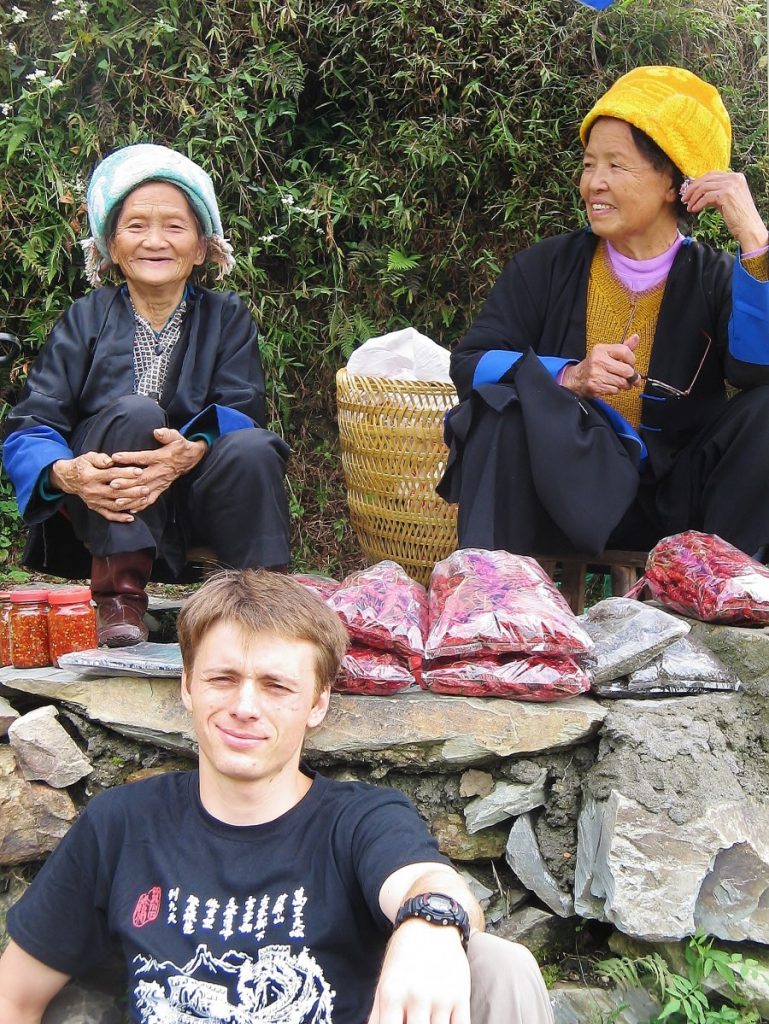
Trade in China is practiced throughout life because work in China is a way of life.
The next day we went to the city park, where I had to push myself to get more money for the ticket and it was also nice. I particularly liked the calm and concentration of older chess players, but given the beautiful surroundings of Yangshuo the park itself was not dazzling. Delicious for breakfast. This time we were served steamed dumplings, which were the specialty of the Guangxi province.
After spending a few days in the town and its immediate vicinity I wanted to go on a trip to get to know this area better.
Moon hill and surroundings
The next day, I wanted to see something else and thought that we would go to the well-known Hill of the Moon, the top of which ends in something like a big ring. It is only 380m high, but I felt that climbing to such a special place would be something special. We took local transport again, which was a kind of adventure. First, I took Monika to the smallest, least attractive hole that was closest to Yangshuo. We sat down in the worst place and we wanted to feel what it is like to be there. We tried to talk to people and they also talked to us, but without success. We took some photos and then walked towards our top. On the way, we met one peasant who led us to the river where there were rafts but unfortunately too expensive to split the costs for two people. An interesting fact here is that wherever we were on the river, we saw small bamboo fishing rafts and cormorants tied to them by one leg. This is the way fishermen catch fish in these parts. They cast their nets and cormorants chase their prey and do not swallow fish because they have narrow rings on their necks. It’s good that at least they don’t end with the platters, and what’s more, many of them are treated like pets.
We walked through the rice fields, with characteristic mountains, banana trees and ponds covered with exotic vegetation in the background. After a longer march, we reached the top, but as I had anticipated, the entry was of course paid. We, however, got through the gate for free, because we simply did not think that the payment was appropriate in this case. I noticed that in China, as in several other countries where I have been, tourists have to pay admission to some places and the Chinese do not pay anything. Of course, I do not agree with it, so I enter without paying, and if they block my way, I push them and then I enter or pay as a last resort. Some might take it as rudeness, but I only defend equality and client rights, which are among the principles of democracy, even if China is not democratic.
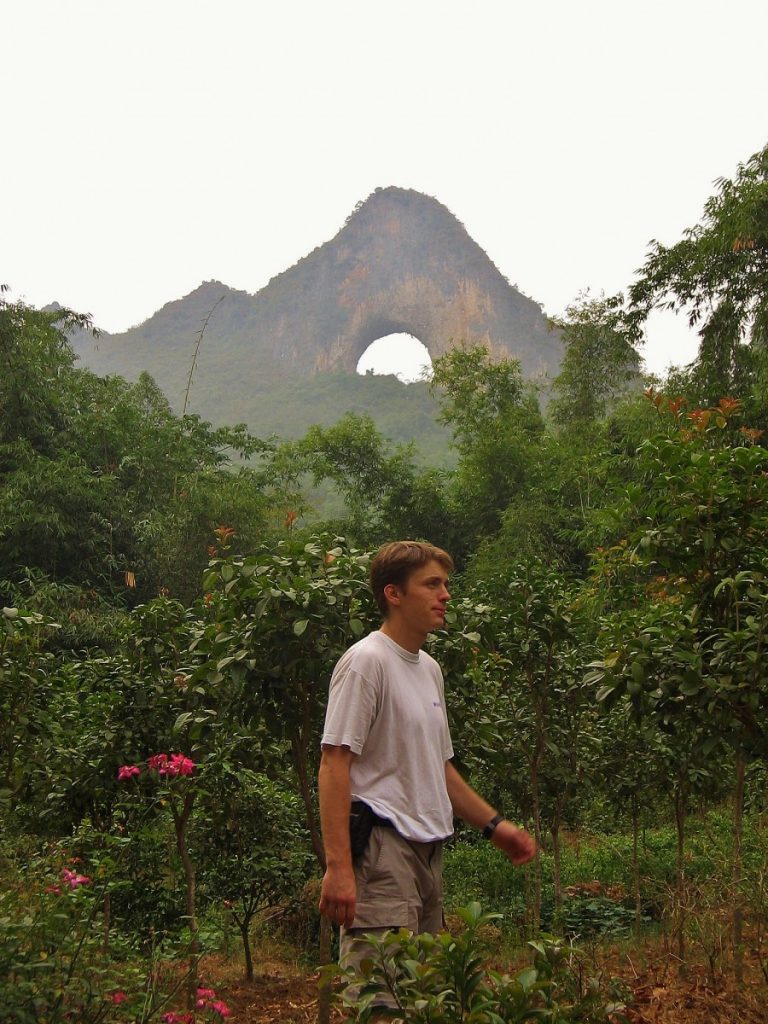
Moon Hill. China.
The mountain was very much covered with bamboo, and from time to time the locals offered water and postcards. It was not a hard march but we had a good training in the Himalayas. We walked all the way up the stairs and every now and then we rested on the bamboo, responding “no” to many sellers. After about an hour we reached the top completely sweaty because it was not only hot but very humid. From here we saw a beautiful view of the mountainous region, and a long-awaited carving of a ring-shaped mountain. It was worth to come here and climb to the top because this type of formation was unique. On the way back we were accompanied by two old Chinese who collected the chrust with which they were very cheerful and who sold us water. I will mention that there are some interesting caves on the way to Moon Hill, but we were not prepared that day. We had another priority then.
To sum up it was a very nice but hard day that gave us the opportunity to see the real Chinese village.Climbing highly recommended.
Li river cruise
I also organized a boat trip on the Li River for us. It was not a problem because in Yangshuo every second inhabitant of the city wants to arrange this trip. After getting the guidelines, we got on the local bus and drove the old bus through the rice fields. It was a great opportunity to once again see Chinese rural life and the people boarding the duck bus. A cruise on the Li River is one of the must-see attractions of this region because it allows not only to swim on the river but also to see the beautiful mountains and the surrounding nature. I could say that after seeing the fjords in Norway, these mountains were no longer something special, but I would be wrong. The mountains of Guangxi and the Norwegian fjords are two different stories. From the boat, I could watch people working here, and the buffaloes swimming and crossing to the other side of the river. It was a very nice and unusual addition to the cruise as well as the view and the experiences that I am always looking for in my trips. The combination of beautiful mountains and rivers with people doing their laundry on the shore and fishing from bamboo rafts was beautiful. I also saw buffaloes bathing in front of them, all in the Chinese landscape. It was the experience we needed in this province.
Here I am reminded of my beautiful Thailand, Vietnam and Laos where people looked similar and did the same work on the shore, having their wooden huts nearby. I am also reminded of Myanmar (Burma) where, while traversing this beautiful but also very poor country, I was driving through rice fields on a road full of pits. Listening to local hits, I saw the same buffaloes bathing in huge holes right next to the road. While on a boat on the Li River, other boats were passing by and people were always waving us. It was a beautiful, idyllic atmosphere in one of the most beautiful parts of China. After leaving the boat, however, we had to deal with poverty. With older people left on their own and with modest houses where they enjoyed little things. One of them was, for example, when we entered one of the houses to spend time with a small child. The parents were happy that we devoted some time to them and it was also a pleasure for us. I took some very realistic photos and we went back to Yangshuo, where we went to sleep after the delicious steamed dumplings.
Road to Chengdu
It is very often that not only concrete places are a great adventure for me, but also get into them.
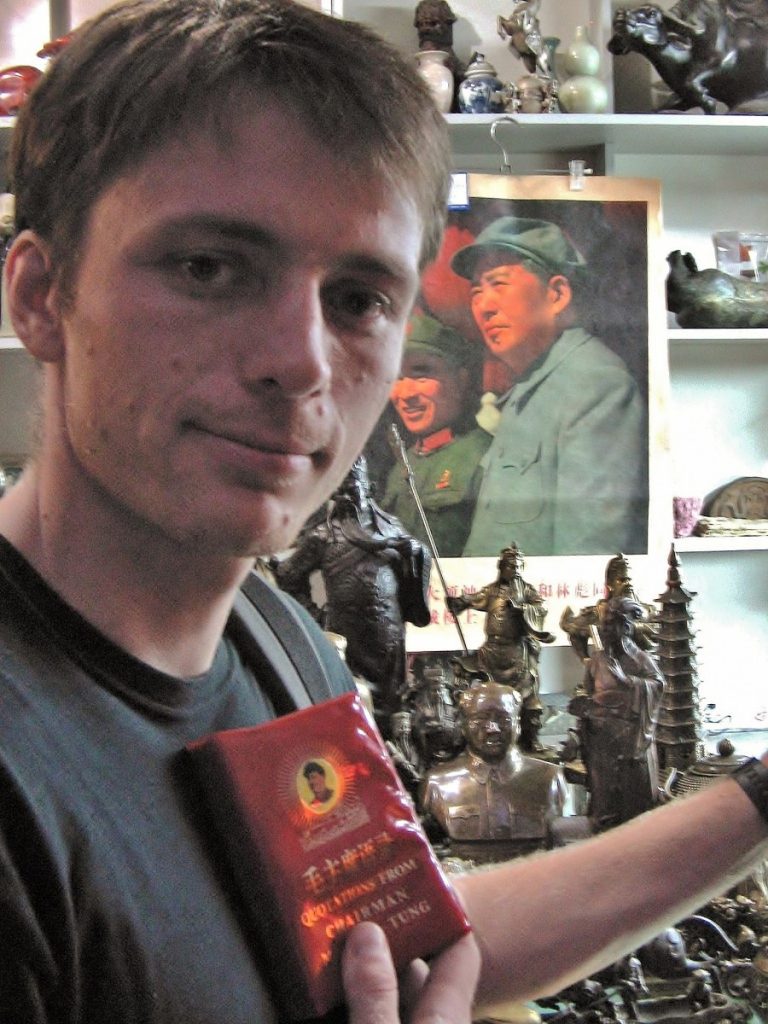
The Communist propaganda of Mao Zedong. China.
This time we set off by bus to Chengdu in Sichuan Province. There was a 26 hour drive ahead but such a distance in China was a normal thing. While driving, we were able to watch Chinese versions of the movie, but unfortunately the driver distracted us with a very loud saliva and spit out of the window, which is common in China. I have also developed a new way of ordering food and getting what I want. I just go straight to the kitchen and point the finger at what I want and how much and then give the sign to me to write for how much. This is the best and least disappointing method I have ever used. I would like to order normally but on this day my chinese was not too good.
If I’m talking about food, I’ll mention the rest of the horror that I described in one of the previous reports, about toilets. When I was driving to Chengdu I saw a toilet in which I could not believe it. It was a large, common trough separated by barriers without doors where anyone could handle the witnesses. From time to time a qualified person poured a bucket of water at the beginning of the trough, so that the man crouching in one of the baffles could see the flowing shit of neighbors from many meetings. I think this is one of the better Chinese inventions !!!
Sichuan Province
Chengdu
After getting to the place we went to the hostel where we lived on a huge 15 person attic. It was very nice and there was plenty of space. I used to have our housing coupons here so we did not pay for the rent for two days. This hostel was a very good experience because it was located in an old, four-storey Chinese house consisting of wooden logs and terraces. The roof and the red lanterns were typical. It was a dragon hostel and the building was originally from the Qing dynasty. You can feel the spirit of old China. Outside, there was a street where only the ground was covered with deep pits, but to my surprise it was one of the tourist centers where tables were bowing under the weight of Chinese food. I will also mention that Sichuan Province is probably the most flourishing cuisine in China. Many of the dishes consist mainly of chillies, so be careful. I ordered a dish once for people who did not speak English and were fortunate enough to give me water quickly.
Chengdu itself is just a big city, just like any other in China. Chengdu is a rather modern city where there are quite a lot of new buildings and old ones which are more interesting from the point of view of tourism being demolished. This is a good place to do shopping like clothes or electronics, but very bad in terms of art and souvenirs. The monument of Mao Zedong, with its hand pointing to the people, deserves attention (just because it can not be overlooked). We spent several days in Chengdu but as it turned out the most interesting is what is located outside the city or on its outskirts. One of the most crazy things we did here was the crazy rickshaw ride. It was already the night, and our trainer drove through the red light, once on the road, once on the sidewalk, and always very fast. We had a great time, and the rickshaw was very old-fashioned.
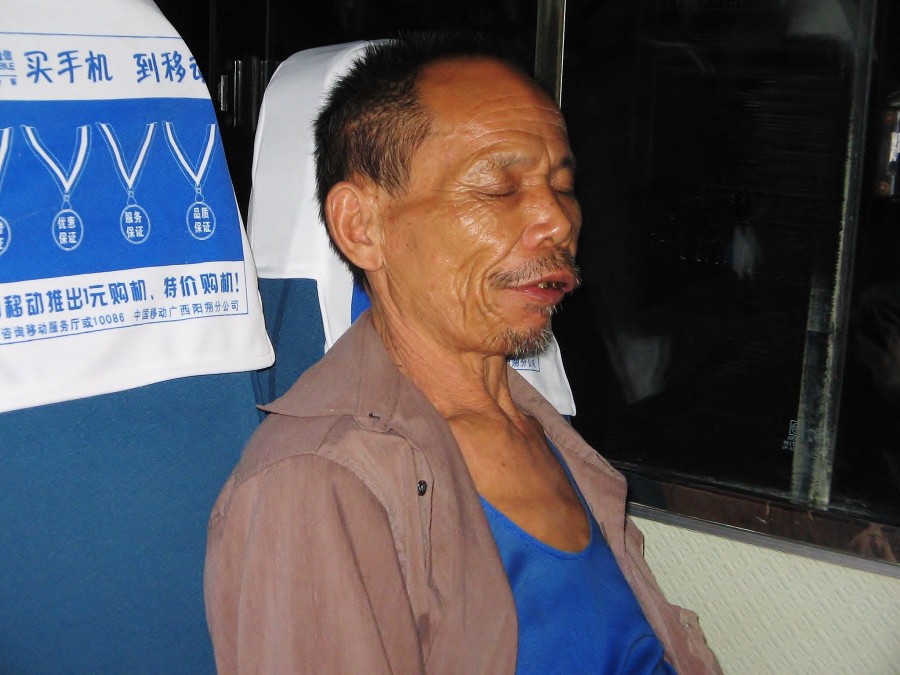
One of my favorite faces when traveling in China.
After two days we changed the hostel to another and better, where it was closer to the center and it was much nicer. It was a Sama hostel where the rooms were very basic but the tourist facilities were great. The garden was a nice pub, internet, travel agency and even a ping pong table. This hostel was very convenient for us because it was in the center of old Chinese architecture where there were many interesting buildings and streets. Nearby is one of the most beautiful temples, Wenshu. It was a complex of temples from the Tang dynasty. All objects are considered to be one of the best preserved in China. I mean the characteristic roofs, sculptures and colors. We spent a few hours at this temple because it is definitively worthy of attention. I also paid attention to a nicely located pond where a lot of turtles swam. Fortunately not to eat but to see. It is nice that the Chinese are also able to appreciate the beauty of these animals outside of the dish. The area around the temple and the whole area built a few centuries ago was a great opportunity to admire the architecture and sculpture, try sharp dishes from Sichuan province and make business with many sellers. There were flower vendors, turtles, fireworks and kites, blind future prophets and professional printers. Contact with each of them was a good experience.
Another day passed me no one knows when. I took one night for a double room as it is nice once in a while to have some privacy. I also started planning our trip to the long awaited Tibet (separate and detailed report about this country) and tried to buy the cheapest air ticket. My talent for business and experience in the travel industry has saved us a total of $ 200, for which we can live here as kings for a few weeks. I treated it as a personal success. Also during these few days we were preparing for another part of our trip.We had to get some of the necessary stuff. I spent a lot of time on the internet and read books to find out as much as possible about the countries we would soon visit. We also did some things for the body: we were at the pool, sauna and jacuzzi. In the evening we also went to the People’s Park. It was a pleasant walk among the bonzai trees, pools, vegetation and souvenir shops and art. Unfortunately the prices were very high. I made a good photo of Chairman Mao in a green uniform, holding his propaganda book in his hand.
Early morning the next day, because already at five, we got up to catch the flight to our next destination. To the place of mystery on the “roof of the world”. We flew to Tibet !!!
Chengdu Research Base of Giant Panda Breeding
Being in Chengdu, we got up once before seven in the morning to see what we really came here for. Our goal was the Giant Panda Breeding Research Base in Chengdu. We had to get up this morning because it was feeding time and the time when the pandas were active. Pandas are still an endangered species and at the same time a cultural heritage of China. There are 11 such centers across the country where scientists are trying to multiply them and make sure that the species survives. However, it is not easy, because pandas are very specialized in food. Out of several hundred varieties of bamboo, they eat only 20. Moreover, during the mating season, females do not allow every male, only the one they want to eat. The female usually gives birth to only one young and when she gives birth to two, she rejects the other or even both. Scientists artificially fertilize pandas in such centers and produce very fast-growing bamboos, which adult pandas eat up to 20 kg per day. Immediately after birth, baby pandas are often taken from their mothers and raised by humans as their lives are too precious to risk losing them.
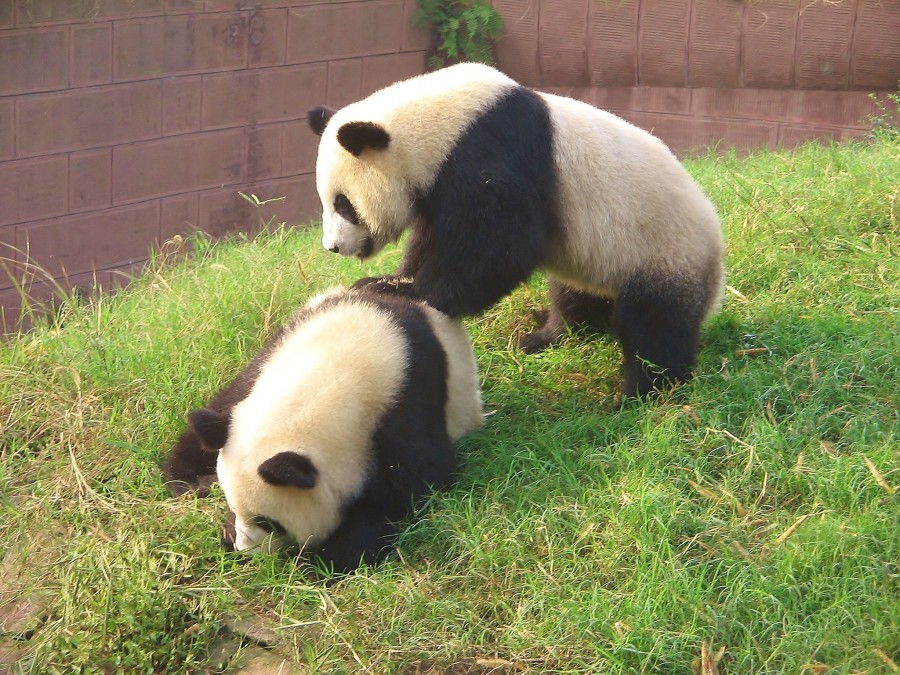
Pandas are symbols of China.
The center itself and the pandas, of course, were one of the most beautiful experiences I have had here. I saw adult pandas feeding and playing. They eat in different positions, including sitting on two legs, in trees, on their backs, etc. Pandas are very funny, they turned over and played with each other all the time. There are special enclosures built for them with trees, bridges, caves and a river. It was evident that they are very neat and they do not lack anything. In China, saving the panda is rewarded with doubling the annual salary, and for those who kill the panda even the death penalty. It is also forbidden to build anything and settle in the areas where they live freely. Being in this facility, I also visited a nursery for pandas where they were bottle-fed, brushed and massaged. Some baby pandas have been in incubators. I’m sure if I was born in China I would like to be a panda. People do not care at all here, but pandas have all the luxuries. It is a pity that it cost as much as $ 50 to take a picture with a panda in your hands, although some people paid more. I did a lot of movies and photos, up close and far. The money is supposed to be used to protect and conserve this beautiful species, and I think this time the Chinese Communist Party is showing some heart because the pandas are really well cared for. There were also baby pandas in this area. Let me remind you that these are completely different animals because they belong to the raccoon family, while their great relatives are to bears.
The whole center is very informative and fun. I think when visiting Chengdu you should come here first.
The Leshan Giant Buddha
While still in Chengdu we took a trip to Leshan – 2 hours drive away. We had to see beautiful temples and the nail of the program, the world’s largest Buddha carved in the rocks. The town of Leshan although certainly enjoyable to spend one day here was not my destination here. I visited them from the local bus window, which was very slow and I could see how it looked. Leshan attracts tourists because of the largest (71m) Buddha in the world. Book data indicates that his ears are 7m long and the largest toe is 8.5m. But before we got to Buddha we had many other attractions by the jungle full of amazing views. It was a collection of temples set up on jungle rocks, between palms, banana trees and waterfalls. Some of them had to walk down the narrow, very high stairs that were hidden in the caves. There were also many great statues of Buddha carved in the caves and high in the mountains.
I think it would be a great place to film adventure movies. The whole place seemed as if we were moving in a few centuries back and the fog on the top of the mountain and the high humidity added to the mood of this unique place. (We only wish that this mood was broken at the very beginning when we had to pay the price of the white man). After a few hours walking through the mountains and caves rich in sculptures, we reached the bay where in the great mountain was carved the largest Buddha in the world. Construction started in 713 and lasted for over 100 years and therefore its originator unfortunately has not finished construction. This Buddha is seated on the seashore in a sitting position, and to chisel in the rocks, the monks must chase straight from the sea and thus (I presume) back the land a few meters. It is an unbelievably great sculpture making a great impression, even with its size. Respect and admiration awakens here in such a great undertaking.Fortunately, there are stairs attached to the rocks, which gives you the opportunity to see the Buddha from many angles.
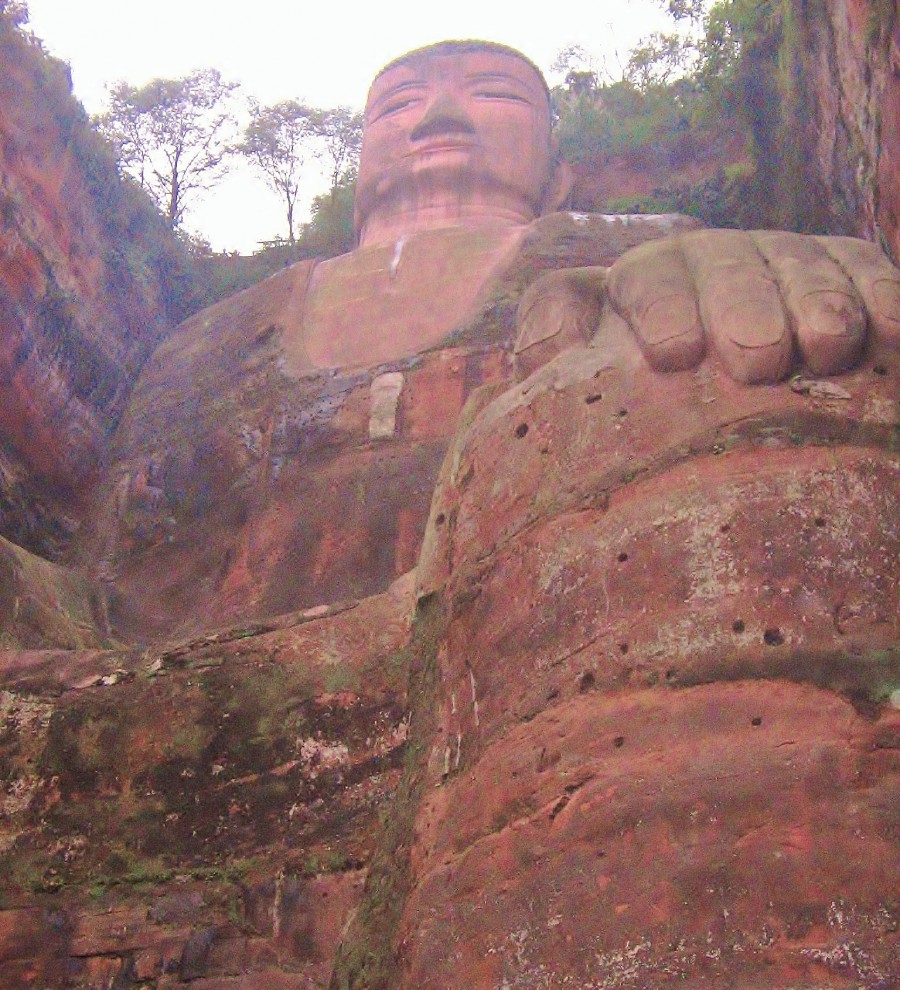
The Leshan Giant Buddha.
It was a very successful day, as usual filled with new adventures and experiences. Being in Chengdu I strongly recommend arriving to this unique place, especially since it only takes about two hours. The whole property is unforgettable.
The summary of China
Traveling for over a month and a half through the main part of China, I would like to summarize this gigantic country of paradox. I spent here beautiful and very informative moments of my life, from which I have unique photos and videos as well as memories and feelings that will accompany me for the rest of my life. Thanks to China, I have understood many things that were previously foreign to me and that made me more sensitive to political and cultural issues, not only here but around the world. I believe that China is a huge machine whose economic growth is racing at breakneck speed and which is changing all the time. I also had contact with people who traveled the world for decades and write articles for the most prestigious world newspapers, thanks to which I was able to educate myself even better. China was closed 20 years ago and everyone wore green uniforms. When the Chinese saw the white man then, they watched him like the eighth wonder of the world, although even today they often take pictures of me from hiding.
Today’s China is (with some exceptions) a country open to tourism where white people are seen quite often. It is an extremely interesting country which, apart from being modern, retains the beauty and simplicity of rural life and the rich culture inherited from its ancestors. Also the communist system in China, although very corrupt and ruthless in some matters, is constantly evolving for the better because strong trade ties with the West force it to do so. The Communist Party and the legendary Mao are no longer a religion, and while people are afraid to talk about it or don’t know the real story, I got the impression that some people are talking about it in a not quite serious way. I also heard a forecast from a Chinese that there could be democracy here in the next 20 years. It is very important that there are Chinese who also travel. Those who did not have this opportunity and speak English talk to tourists about history and politics and then pass it on to others. As for today’s Chinese, the middle class has no manners and is simply rude in manners, but they are still learning. Students speak English and want to learn and crave contact with the West. This means that, in retrospect, the country is moving rapidly forward.
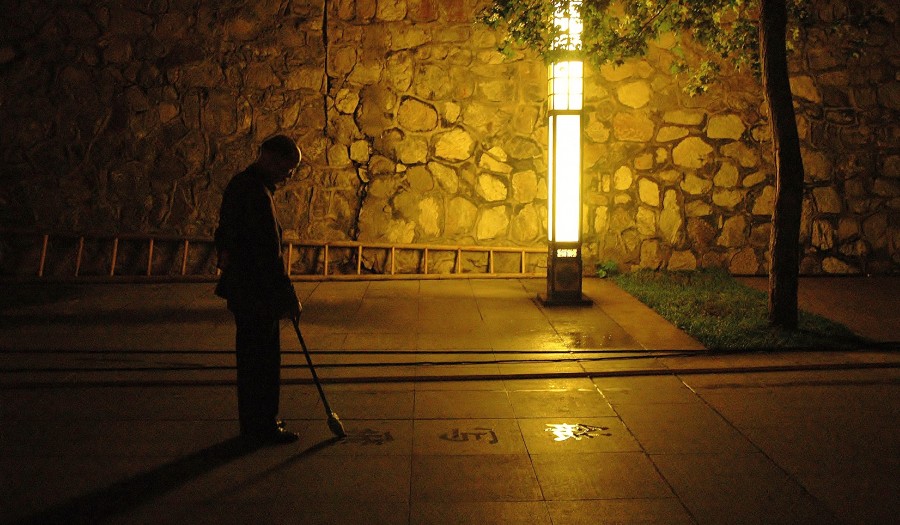
Chinese street calligraphy in Xi’An.
However, I would like to emphasize that I spent almost two months in this huge country and it was only in a very Chinese part of it. My experiences, adventures, experiences, opinions and descriptions are definitely not relevant to all other regions of the great People’s Republic of China, for they are no longer true China.The special autonomous and administrative territories of this country are a different story, and I have written about them in other reports, dividing them into other countries.
(There are separate reports about Hong Kong, Macao and Tibet; and who knows, maybe one day also about Turkestan, Taiwan and Inner Mongolia).


































